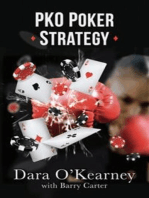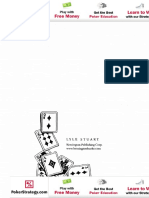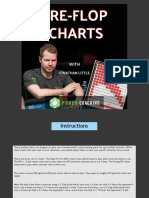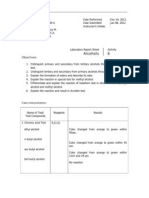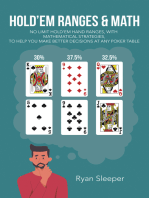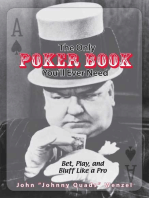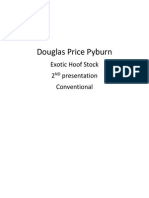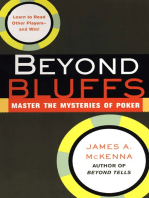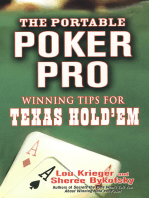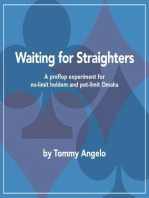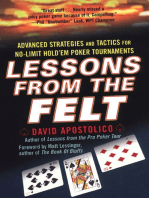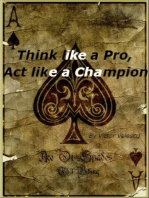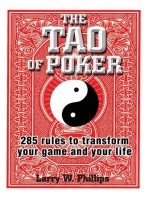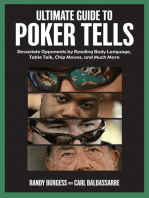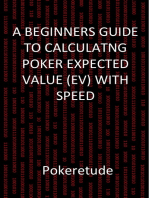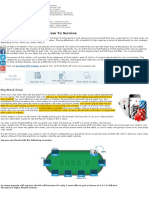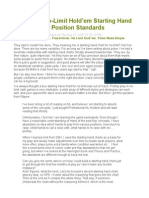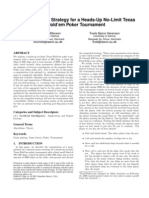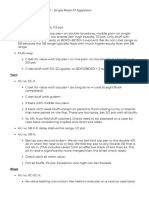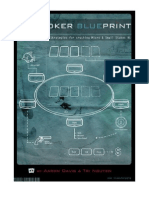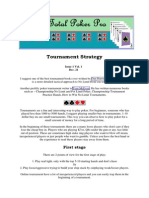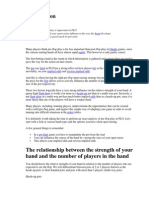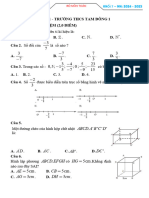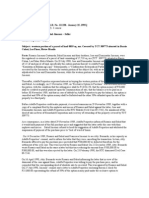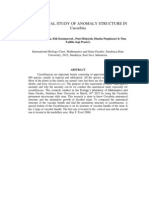4 - The Poker Puzzle by Oliver (Improva) Marx PDF
4 - The Poker Puzzle by Oliver (Improva) Marx PDF
Uploaded by
MikeCopyright:
Available Formats
4 - The Poker Puzzle by Oliver (Improva) Marx PDF
4 - The Poker Puzzle by Oliver (Improva) Marx PDF
Uploaded by
MikeOriginal Title
Copyright
Available Formats
Share this document
Did you find this document useful?
Is this content inappropriate?
Copyright:
Available Formats
4 - The Poker Puzzle by Oliver (Improva) Marx PDF
4 - The Poker Puzzle by Oliver (Improva) Marx PDF
Uploaded by
MikeCopyright:
Available Formats
Free $50
Free $50
Free $50
Version 1.0076
Cover:
Melville and DonkHero
People who helped me make this text readable:
All my students, family and friends
Free $50
Free $50
Contents
FAQ
Perceived strength and honesty
8
10
Scare cards
12
Points of honesty
12
Exercises
14
The continuation bet
15
Let board texture be king
16
Final notes
17
Exercises
18
Ranges and bet sizes
Actual strength of range and bet size
19
21
-- The Value Bet Conjuctures
23
-- The Bluff Catching Conjectures
23
-- Positional awareness
24
Words on balance
Range types and their behaviour
24
26
Elastic and inelastic ranges
26
-- To bluff or not to bluff
28
-- The Elasticity Conjectures (TEC)
28
Free $50
Free $50
Capped range
30
Exercises
32
Dry flops as the preflop raiser
33
When our perceived strength is good or better
33
-- Strong made hands: TPGK or better
34
-- Made hands: TPNK - strong 2nd pair
36
-- Weak made hands and air
37
When our perceived strength is okay or poor
38
-- Strong made hands: TPGK or better
38
-- Weak made hands and air
39
Wet boards as the preflop raiser
The Plans
41
42
-- Versus aggressive players
42
-- Versus passive players
44
-- Versus good players
45
Bluffing when a draw gets there
46
Exercises
48
the preflop calling range
49
In position as the preflop caller
51
-- Fit or fold players
51
-- Players with a polarized c-betting range
51
Free $50
Free $50
Bluff raising
51
Exercises
53
Out of position as the preflop caller
54
The donk
55
Donking the turn
57
Check-raising the flop
58
Check-raising the turn
58
Exercises
60
Fine tuning the 3-bet
A starting point
61
61
-- General comment on bet sizing
62
-- A word on trash
62
-- Possible adjustments
62
-- Things to consider
63
Players who fold a lot to 3-bets
63
-- Bet sizing
67
-- Postflop play
67
Players who call a lot of 3-bets
67
-- Bet sizing
68
-- Postflop
68
Exercises
70
Free $50
Free $50
Defending against 3-bets
71
4-bet bluffing
71
Calling 3-bets
72
-- Adjusting to the situation
72
-- Postflop play
73
Exercises
Developing Reads
76
77
VPIP and PFR
77
Flop and turn
78
-- Low c-bet percentage
78
-- High c-bet percentage
79
Check-raise tendencies
-- Players with a balanced check-raise range
80
81
The River
81
Taking Notes
82
Exercises
84
The Cinema
85
-- Playing as the preflop raiser
85
-- Adjusting the preflop calling range.
86
-- Playing 3-bet pots
87
Free $50
Free $50
Free $50
Free $50
FAQ
Can I copy the book?
The short answer is no.
Can I print the book?
Yes, in as many copies as you would like to.
I have heard the book comes with coaching. How many hours?
Two.
What if I want to get more coaching?
Additional coaching will be arranged on a case by case basis.
The main problem is that I have limited time.
I dont need any coaching I just want the book. Do I get a discount?
No.
Why is your book so much cheaper than some of the other
poker books?
Because I prefer to ask a price that I personally think is fair.
Will you update the book?
Yes, as often as possible?
How do I get the updates?
I will announce them on thepokerpuzzle.com and on
deucescracked.com. The updates are free for at least 6 months.
I expect to update the book on a monthly basis.
What will you update the book with?
All new poker knowledge that my readers find relevant will find
its way into the book.
Updates are going to be driven by requests from the readers.
Free $50
Free $50
Where can I get the lastest version of this book?
http://thepokerpuzzle.com/member_area/ send me an email
and ask for a username password.
Do I need to be a member of deucescracked.com to buy your
book?
No, but if you are serious about your poker game you should.
Free $50
Free $50
Perceived strength and honesty
A fundamental question - if not the fundamental question - we have to
ask ourselves in poker is: Why do people fold?
Definition
Perceived strength ~ actions + texture + position + image + level
Actions
When we bet, raise or re-raise our perceived strength goes up. The
preflop raiser is perceived to have a stronger range than the preflop
caller.
Texture
If we are the preflop raiser and there are high cards on the flop, our
perceived strength goes up.
Position
Early position adds to our perceived strength since we are expected
to raise with a stronger range of hands.
Image
If we have been c-betting a lot and have been caught bluffing our perceived strength goes down.
Level
If the villain knows that this is a bad board to c-bet as a bluff and we
still c-bet our perceived strength actually goes up.
So, based on our actions, the board texture, our position, our image and
villains level we can in a sense calculate our perceived strength. The
better our perceived strength, the more plausible our line looks.
Perceived strength is the strength of our perceived range.
Obviously it is not easy, if at all possible, to make any exact calculations
since we have incomplete information, so estimates will have to do.
You can freely choose how you prefer to mentally represent perceived
Perceived strength and honesty
10
Free $50
Free $50
strength. The words you use are not important but it is important that
you actively do think about it when you play.
I personally like to use words like:
Excellent
Good
Okay
Poor
The better our perceived strength the more bluffs we can have in our
range. The reason is simply that it is - in most cases - difficult for the
other player(s) in the pot to play back at us often enough in order to
make our bluffs -EV since we are telling a very plausible story.
Let us say that we open in early position and we get called by the player on the button who happens to hold pocket nines. The flop comes AJ4
rainbow. Our perceived strength on this board texture is excellent, and
if we fire a c-bet there is a good chance that the preflop caller will fold.
He might peel one but there is a high chance that he will fold. Pocket
nines cant be too happy on that flop.
If we change the board texture a little, so that it becomes A74 rainbow,
our perceived strength is no longer excellent. It is just good and pocket
nines are looking a little better. Many players will call and re-evaluate
on the turn when holding pocket nines.
If we change the board texture one more time to say 742, there is no
chance that the preflop caller will fold pocket nines to one bet.
The conclusion is that there is a connection between our perceived
strength and how likely it is that the preflop caller will fold his hand.
Obviously the preflop caller will not fold if he connected with the
board, but since this is No Limit Holdem and nobody ever has anything, this is of less relevance.
The motivation for introducing the concept of perceived strength is
to make the thought process smoother. It is much easier to think, My
perceived strength is very good than to think, My perceived range
Perceived strength and honesty
11
Free $50
Free $50
hits the board texture hard, so when I bet I can represent a lot of strong
hands. Here perceived range is the image the other player has formed
in his head based on the actions you have taken so far.
Scare cards
I often hear people say that they will fire again on any scare card on the
turn. This may or may not be a good strategy against the other player
in the hand. We are assuming that we know which cards we can use to
scare the villain.
Definition
A Scare card is a card where our perceived strength goes up.
In mid stakes poker there are fewer scare cards on turn than there
used to be. The problem is that on the turn the scare cards are often
very obvious and therefore much less scary. Furthermore, many players
will actually check on scare cards with their medium strong hands way
too often. This means that they polarize their range when they do bet,
since they either have a bluff or a very strong hand.
This may sound a little paranoid but the point Im trying to make is that
scare cards should be part of a tailored strategy, and not just auto bluff
cards. Later we will identify when we should be using scare cards as
scare cards.
Points of honesty
Every poker player has spots in his game where he tends to become
honest. This honesty is often a result of the reactions of the other players at the table but it can also be a result of his natural style.
Definition
A point of honesty is a situation where a player will only continue to
put money into the pot with a strong hand.
Preflop most players tend to become honest when they are 4-bet. In
other words they are not 5-bet bluffing or defending light often enough
that we need to be taking it into account. The situation we create when
we 4-bet is an example of a point of honesty for the villain.
Perceived strength and honesty
12
Free $50
Free $50
Assumption
The better our perceived strength is in a given situation the more
likely it is that the same situation is a point of honesty for our opponent.
Postflop most players have points of honesty deeply integrated into
their style.
When we are making a plan for our hand it can be a great help if we can
define when we expect villain to become honest. In other words we can
ask ourselves, Where is villains point of honesty on this board texture? Our answer will depend on:
1. The villain in the hand.
2. What our hand looks like if we call, bet or raise.
A simple illustration is a double barrel on a dry flop. When we c-bet it
looks like we have top pair or better, but everybody c-bets dry flops so
we get called by a lot of second pair type hands. When we fire again on
the turn it really looks like we have top pair or better. Our perceived
strength increased when we bet the turn and it is very likely that our
opponent will fold most of his second pairs on the turn. Unless he
thinks that it is very likely that we are bluffing there is no reason for
him to bluff catch again.
When we are the preflop caller we should adjust our calling ranges
both preflop and postflop to villains expected points of honesty.
In general it is better to have outs than marginal showdown value
against an aggressive player. The reason is that, on a lot of turns, we
will find ourselves in a spot where both folding and calling are potential big mistakes - we would play the hand in a very different way could
we see villains cards.
Perceived strength and honesty
13
Free $50
Free $50
Exercises
1. One way of getting used to actively think about perceived strength is
to watch a video where you classify every flop.
What is the perceived strength of the preflop raiser on that board
texture?
When you do expect the players in the hand to reach a point of
honesty?
2. The next step is to play a short session of roughly 15-30 minutes
where you play without looking at your cards. Turn off the HUD too.
Your strategy will be to play every hand in late position and c-bet
when you think your perceived strength is good enough. There are
various tools that can cover your cards.
http://software.deucescracked.com/DCTiltblocker.zip
Perceived strength and honesty
14
Free $50
Free $50
The continuation bet
Okay, so we raised preflop, got called, and here comes the flop. This
is likely to be the most common spot we will find ourselves in our career as a poker player. Therefore it is insanely important that we have
a good understanding of what we are doing, and why we are doing it.
Otherwise we will be making the same small mistakes over and over
again. In short, bleeding money.
We will approach this problem by first breaking down the continuation
bet. The goal is to find some words for our thought process.
Value
We have a made hand, there are worse made hands that can call us
and there are virtually no cards in the deck which will give us the
second best hand.
Villain would not call if he could see our cards.
Value/Protection
We have a made hand and there are worse made hands and draws
that can call us so there are cards that can come on the turn that will
either kill our action or give us the second best hand.
How much we are betting for value and how much we are betting for
protection depends on our actual hand, the board texture and the
other players in the pot.
Semi-bluff
We dont have showdown value but there are cards in the deck that
can help us to make the best hand. We bet because we want to take
the pot down.
Bluff
We have little to no showdown value and there is close to no hope for
our hand. We bet because we want to take the pot down.
When we know what the purpose of our continuation bet is, it is often a
lot easier for us to make a plan for the turn and river. The most obvious
The continuation bet
15
Free $50
Free $50
example is when we are betting for value/protection on the flop, and
so a c-bet on a blank turn card becomes a bet for protection most of the
time. We are only getting value if villain is willing to call a rather big bet
on the turn thinking that he has implied odds.
I will actually argue that a 100% c-bet strategy is a winning strategy at
ssnl and msnl, as long as we know what we are trying to achieve on the
flop and have a clear plan for the turn and river; that said I dont think
it is the optimal strategy.
The story we would be telling is simply not plausible enough and the
other players would start to float and bluff raise us often enough to
make it only a marginal winning strategy.
One often overlooked reason for betting the flop is that it narrows the
range of hands that the preflop caller sees the turn with. If we check/
call the flop we have no idea what hand the preflop caller holds, and
what cards may improve him. We will look deeper into this when we
look at elastic ranges.
Let board texture be king
When our perceived strength is good and we c-bet, we are telling a
story that is very plausible and the preflop callers will have a tough
time playing back at us often enough to make it a losing strategy; simply because their brain is telling them that our line looks plausible.
On board textures where our perceived strength is poor I generally expect to get played back at more frequently; even with a strong over pair
we are still not thrilled about playing a big pot out of position.
In aggressive games, where we get played back at frequently, we are
therefore forced to bluff less.
Against a good player we have to make one more adjustment and that
is to balance our flop play by check/calling and check/raising. Otherwise our lines become too transparent.
But balancing our flop play only makes sense when we are playing
against players who will use their positional advantage well and also
players who are way too aggressive when checked to. In a way we swap
The continuation bet
16
Free $50
Free $50
initiative with position on the flop.
Notice that the checks are different checks. Sometimes we are trapping
and sometimes we are trying to get our hand to showdown. In general
we can check for:
Pot control
We figure that we have the best hand most of the time but we are
not ready to get raised, we expect a bet to mostly get called by better
hands and we dont mind giving a free card.
Equity protection
We have a fair amount of equity in the pot but we cannot stand a
raise and we expect the other player in the pot to raise us with pure
bluffs, semi-bluffs and strong made hands.
Deception
We have a strong hand and we are going for a check/raise or a
check/call.
Give up
We have nothing and are not planning to bluff.
Final notes
I want to stress that we should design a c-betting strategy for each
player as we develop reads on them. This has been a standard strategy
in HU for a long time and should be standard for every good 6-max
player too.
Before you fire that c-bet on the flop try to have a plan for the turn (and
river) as well. I personally always ask myself how big a pot am I willing
to play.
The continuation bet
17
Free $50
Free $50
Exercises
1. Watch a video were you classify every c-bet and every check that
the hero makes. If you find spots where you would use a different
reason than the coach used in the video dont lose your confidence.
They could be using a different set of words to express their thought
process or simply be making a mistake.
2. Go over a HH for a session you recently played and do the same.
3. Play a session where you focus on actively expressing what kind of
c-bet or check you make in every hand you are involved in.
The continuation bet
18
Free $50
Free $50
Ranges and bet sizes
Too often I hear people say, Here I fire a standard c-bet, without actually understanding why it is standard, and without even thinking about
the size.
If we want to improve as poker players we need to start thinking about
everything that we do at the tables and constantly ask ourselves the
question why? In this chapter we will talk a little about ranges and how
to pick the right bet size.
Assumption
The size of a bet affects the range of hands willing to call.
The arguments for this assumption are:
1. If we check call the flop the preflop caller sees the turn card with
his whole preflop calling range.
2. If we bet really big on the flop he will see the turn card with only
the top of his range - or at least the frequency with which he calls
with the bottom of his range goes down.
So, by choosing a bet size we form the range of hands that will be calling our bet (we will later identify something called an inelastic range
for which the above assumption is not true).
Assumption
Board texture matters.
This is just another way of saying that we should be bluffing with a
higher frequency than average in spots where our perceived strength
is good or better; simply because those board textures allow us to tell a
plausible story.
On board textures where the preflop callers expected c-bet calling
range has a lot of equity in the pot we should bet bigger with our whole
range. In general when the board is more coordinated there are not
only more hands that can call our bet, but also more cards that may kill
our action. So the big bet on the flop is not only needed for protection,
Ranges and bet sizes
19
Free $50
Free $50
but also because it is often our best chance to get some value when we
actually do have a strong hand. So, board texture matters.
The foundation for my ABC strategy for picking the right bet size is
simply to bet according to the board texture and the absolute strength of
my hand. How big a pot do I want to play?
Notice that as I learn more about my opponents I will adjust frequencies and bet sizes according to their tendencies. Will the villain notice
bet sizing tells?
So, if I bluff a lot in a certain spot I will be inclined to bet a little smaller.
If Im mostly betting for value and betting with strong semi-bluffs I
tend to bet a little bigger.
The most important parameters are villains range and his tendencies.
A range can be broken down into the following parts.
Nuts
Made hands with which the preflop caller is willing to play for stacks
with.
Strong draws
Draws with so much equity that they do not need any folding equity.
Getting All in on the flop is +EV.
Weak draws
Draws that need folding equity. Some weak draws are disguised. A
gut shot is an example of a weak disguised draw.
Strong bluff catchers
Made hands with so much estimated equity that we are willing to
bluff catch more than one street.
Weak bluff catchers
Made hands with enough estimated equity to bluff catch one street.
Air
Hands with no hope.
Ranges and bet sizes
20
Free $50
Free $50
Before you fire a c-bet you should consider the preflop callers preflop
calling range and match it with the board texture.
How many hand combinations does the preflop caller have that he
will consider the nuts, strong draw, strong bluff catcher, weak bluff
catcher, ... ? I like to mentally name a few typical hands for each part
of his range.
How do you expect villain to play the different parts of his range?
So, depending on the situation the preflop callers range on the turn
will have different compositions. A c-bet is a way for the preflop raiser
to force the preflop caller to decided what he wants to do with the different parts of his range.
Actual strength of range and bet size
The relation between bet size and the strength of our range in a certain
spot is actually a very common strategy in poker:
We raise bigger in early position than in late position.
We 3-bet bigger when we are out of position than when we are in
position.
Some will argue that it is because they dont want to be called and play
the hand out of position, but the real reason as to why their choice of
bet sizing makes sense, is that in general their range is stronger.
A mistake I see many players make when they are playing against a
showdown happy player is that they adjust correctly by lowering their
bluff frequency (it seems like a bad idea to bluff a player that does not
like to fold!) but they forget to adjust their bet sizes. I think there are
two reasons for this:
1. If our standard c-bet size is already 3/4 pot there is not much
room left for flexing our bet sizes.
2. We fear that our change in strategy is too obvious.
Both are valid concerns. The first concern should make it clear why it
is important to bet according to board texture and the player while the
Ranges and bet sizes
21
Free $50
Free $50
second illustrates that game dynamics and the ability to change gear
play a big role in modern poker.
For a range we can talk about the nuts:air ratio. It is a measure for how
often we are snap calling a shove compared to how often we are on a
pure bluff.
In the spots where we expect the villain to call or fold it is actually
more relevant to consider the ratio:
(nuts + value + strong draws + weak draws):air
We could in theory estimate the strength of our range versus villains
by estimating the above ratios, but this is impossible to do in the heat
of the moment. The strength of our hand depends heavily on the reaction we expect from the other player in the hand which again depends
on game flow.
After a session I may try to estimate the range ratio for a player in a
certain spot. This helps me figure out what type of hands I want to use
in my counter strategy. It is not something I do often.
Definition
The strength of a hand relative to the other player, the board texture, positions, pot size, effective stack size and the action is known
as relative hand strength
I prefer to use perceived strength, points of honesty and a basic analysis of how I expect villain to play the different part of his range when I
try to answer the question:
How big a pot do I want to play against this player on this flop?
The reason is that I then play according to the information villain has
available.
Question1: How does the size of the pot affect how villain will play the
different parts of his range?
Ranges and bet sizes
22
Free $50
Free $50
The Value Bet Conjuctures
You cant bet for value if your perceived range does not contain
bluffs.
You can bluff when your perceived range contains hands you are
betting for value.
The more bluffs you have in your perceived range the thinner you
can bet for value.
The more value hands you have in your perceived range the more
you can bluff.
The Bluff Catching Conjectures
Players will bluff catch with a high frequency on board textures
where they have a lot of potential bluff catchers and your perceived
range contains bluffs.
Players will bluff catch with a low frequency in situations where you
have a high perceived strength or your perceived range is weighted
towards hands you are betting for value.
Players tendency to bluff catch depends more on game flow than on
bet size.
If villains tendency to bluff catch does not depend on the bet size, then
the bluff catching conjectures lead to the interesting suggestion that we
should be tempted to bet on the bigger side on flops where we are going for multiple barrels and on the smaller side on flops where we are
often going for a single barrel.
Note: That there are situations where villain will behave in a nonstandard way. One example is when the effective stack is small compared to the pot. Another example is if we for some reason bet really
small or really big and there by create a non-standard situation.
Ranges and bet sizes
23
Free $50
Free $50
Positional awareness
A player is positional aware if he:
Understands how being in position and out of position affects the
game.
Understands that players play different ranges from different positions.
Question2: How does that affect bluff catching tendencies?
Words on balance
Against a player who is rarely bluff raising we should play with a different balance in our range than against an aggressive player who is bluff
raising a lot. The reason is that we will be tempted to fold hands with
marginal showdown value when we are put under pressure. The relative strength of our hand drops as the pot gets bigger.
Question3: What adjustments would you make to your range when
facing a player who is re-raising and check-raising a lot?
Question4: What adjustments would you make against a player who is
rarely bluff raising?
Question5: Against which player is 4-bet bluffing most effective?
Player A, who 3-bets 13% and 5-bet shoves AQ+, TT+ or Player B, who
3-bets 9% and 5-bet shoves AK, JJ+
Some think of a balanced range as a range with equal portions of each
part. I prefer:
Definition
A range is said to be balanced if the ratios between each part of
makes the range unexplotiable.
Question6: What is the natural adjustment of a weak player when put
under pressure?
Question7: What is the natural adjustment of an aggressive player
when put under pressure?
Ranges and bet sizes
24
Free $50
Free $50
Playing with truly balanced ranges is almost impossible and fundamentally suboptimal (in the definition I prefer) because players play different styles and they adjust in different ways when they feel that we are
exploiting them. Playing a truly balanced style is a waste of time.
I will shift the balance in my ranges according to game dynamics, but I
never worry about actually having a balanced range. I prefer to exploit
and adjust rather than try to protect myself from being exploited.
What I do worry about is changing my perceived range.
Question8: When does it makes sense to manipulate the perceived
range?
Understanding how different player tendencies change the composition of the range of hands we face is the foundation of every winning
approach to poker.
Ranges and bet sizes
25
Free $50
Free $50
Range types and their behaviour
Understanding how bet sizing affects the flow of a hand is one of the
most complex aspects of poker. Our best chance is to look at different
types range and how they behave.
Elastic and inelastic ranges
I dont know who coined the term elastic range. The definitions and the
terminology in this chapter is developed together with my students
especially Derek.
Definition
A hand is called elastic (to the bet size) if the size of the bet will affect the frequency with which we get a call.
Definition
A hand is called inelastic (to the bet size) if the size of the bet will
not affect the frequency with which we get a call .
Definition
A hand is called strong if it has enough equity to call.
Definition
A hand is called weak if it does not have enough equity to call.
Whether or not a hand should be counted as elastic, inelastic, strong or
weak depends on the size of the bet and how much equity villain estimates the hand to have against our range.
Some villains are paranoid and will bluff catch flop and turn very light.
Some villains fall in love with draws. In both cases it is our job to adjust
for that when we count.
Definition
The elasticity of a range is defined as the quotient between the elastic hands and the inelastic hands.
#elastic hands / #inelastic hands >= 0
Range types and their behaviour
26
Free $50
Free $50
Calculating the elasticity of a range is a matter of counting hand combinations. I count bluffs catchers and floats as inelastic hands.
Definition
A range is said to be super elastic if its elasticity is greater than 0.8.
If villain has an elastic range we can, with our bet size, adjust the frequency with which we will get called by certain parts of his range, and
in that way increase our expected value.
Definition
A range is said to be inelastic if its elasticity is less than 0.2
If villain has an inelastic range we know that the majority of his hands
will be inelastic to our bet size.
Definition
A strong-weak range is an inelastic range which consists of a strong
part and a weak part.
An example of this is the preflop callers range on the turn on a Kinghigh dry flop after the preflop raiser has c-bet the flop. The strong part
consists of top pair and better while the weak part consists of second
pair hands and floats.
Definition
A polarized range is an inelastic range which consists of nut like
hands and air.
Putting villain on a range is the first requirement for becoming a successful poker player. Understanding how the nature of villains range
affects our strategy is the second.
Question9: Can you give an example where villains range is polarized?
Question10: When will villains range on the turn have a high elasticity? Hint: It depends on the board texture.
Range types and their behaviour
27
Free $50
Free $50
To bluff or not to bluff
One application of the above definitions is that they allow us to evaluate if a spot is a good spot to bluff without equity.
#weak hands / #strong hands > bet size / (bet size+pot size),
where #weak hands is the number of hands we expect villain to fold
and #strong hands is the number of hands we expect villain to the bet
we have in mind.
The left side of the equation tells us how often we can expect the bluff
to work. The right side of the equation tells us how often it has to work
to show a profit, if we assume that we have no equity against the strong
part of villains range.
When we are semi-bluffing we have so much equity that it becomes an
important factor. If eq (a number between 0 and 1) is our equity the
equation becomes:
#weak hands / #strong hands > bet size (1-eq) / (bet size+pot size)
If a bluff with zero equity has to work 2/5 (0.4) of the time, then it has
to work 8/25 (0.32) of the time when our equity is 0.2 . Here we are
not even considering implied odds.
The Elasticity Conjectures (TEC)
tec1: The more inelastic the range is, the fewer hands we can value
bet.
tec2: The more elastic the range is, the thinner we can bet for value
and protection.
tec3: The more elastic the range is, the bigger we can bet without
making the range inelastic.
tec4: The more inelastic the range is, the bigger we can bet for
value when we have the best hand.
tec5: The more inelastic the range is, the smaller we can bet when
we are bluffing.
Range types and their behaviour
28
Free $50
Free $50
tec6: The more elastic the range is, the better it is to bluff on scare
cards.
It is important to remember that there are degrees of elasticity. It is
not a black and white world. As with perceived strength I prefer to use
simple words to express the degree of elasticity.
Super elastic
Flop is QT6tt we fire a c-bet and the turn is a blank. The preflop
caller has a super elastic range on the turn.
Very elastic
Flop is K65tt on a blank turn the preflop caller has a very elastic
range.
Elastic
Flop is KQ5tt on a blank turn the preflop caller has an elastic range.
Inelastic
Flop is J62r on any turn card the preflop caller has an inelastic range.
Question11: How does non-blank turn cards affect the calling range on
the turn?
Now dont worry if you cannot see how you can use this in your own
game to pick the right bet size. I understand that the conjecture is a
big mouthful, so we are going to look at some different types of board
textures where we are the preflop raiser.
My goal is that you as the reader will start thinking about how elastic
villains range is and use that as a guideline for your choice of bet size.
But before we do that let us see if we can use the elasticity conjecture
to figure out how to play against two player types.
The calling station
A calling station is a player who will call almost any bet if he has a piece
of the board or holds an ace. He shows up with a very elastic range in
spots where you would have expected it to be inelastic (the range is
elastic but it was played in an inelastic way).
Range types and their behaviour
29
Free $50
Free $50
For example: You bet the flop and the turn rather big compared to the
effective stack and villain showed up with 3rd pair on the river or maybe a missed gut shot with tainted outs.
If TEC is any good it should tell us what counter strategy we should use.
His range on the flop can be described as [has a piece, no piece]. The
has a piece part is literally any piece and includes ace high hands and
fourth pair. This diversity results in elastic ranges in spots where we
would normally expect strong-weak ranges.
The definition of an inelastic range tells us that he will call almost
any bet sized if he has a piece.
Tec2 tells us that we should bet thinner for value and protection.
Tec3 tells us that we can bet bigger than we normally would.
Tec5 tells us that if we c-bet on the flop as a bluff we should bet
small. We dont need to bet big in order to get him to fold air.
Tec6 tells us that we should be looking for scare cards if we want to
bluff on the turn or the river.
Does this sound like a good strategy against a calling station?
Fit or Fold players
Fit or fold players will generally show up with more inelastic ranges
than other players.
Tec4 tells us that we should just bet big when we have a strong hand.
Tec5 tells us that we can bet small when we are bluffing.
So Tec can not only serve as a guideline for choosing the right bet size
it can also help you answer the question why and help you figure out
what strategy you should be using against a player depending on how
elastic his ranges are.
Capped range
As with many other concepts in poker there are several definitions of
capped range.
Range types and their behaviour
30
Free $50
Free $50
I personally prefer to define a capped range as:
Definition
A capped range is a range where either the top or the bottom of the
range is missing.
Against a top capped range we can run bluffs since the villain never has
a strong hand.
Against a bottom capped range we should never bluff catch. The typical
example is nits who by design have a range capped at the bottom.
In general poker is full of capped ranges:
Players who rarely 4-bet bluff have a capped range when they
4-bet.
Players who rarely double barrel have a capped range when they
suddenly bet the turn.
Players who fold a lot to 3-bets have a capped range when they
suddenly call.
Players who fold to a lot of c-bets have a capped range on the turn
when they suddenly call.
Range types and their behaviour
31
Free $50
Free $50
Exercises
1. Go over a hand history of a recent session and try to classify the
elasticity in the hands you were involved in. Both as the caller and
the aggressor. Start by looking at the range of hands willing to call a
c-bet. How did the bet sizes on the flop and turn affect the range?
2. Watch a video and try to classify the elasticity on the turn in as
many hands as possible. Dont pause the video unless you have to.
3. Pick 5 hands from you database where you are the preflop raiser
and evaluate if the turn is good spot to bluff with air (0 equity).
Range types and their behaviour
32
Free $50
Free $50
Dry flops as the preflop raiser
Because there are no or very few draws on a dry board we are almost
always way ahead or way behind with our made hands. The preflop
caller rarely has big pairs in his range since he would 3-bet them preflop.
All in all this means that unless the preflop caller has managed to flop a
set or top pair he will often fold if we put him under (enough) pressure;
for example if we fire a second barrel on the turn.
We dont get played back at very often - or at least as often - on the dry
boards, because there are fewer hand combinations the preflop caller
can represent with a raise or check raise on the flop.
This means that the standard bluff lines for the preflop caller at ssnl
and msnl becomes a one street floats and bluff catching. Maybe if
things are really wild that Friday afternoon a two street float or a bluff
raise on the turn; both very profitable lines given a good read and the
right table dynamics.
The lines that I will take as the preflop raiser against most opponents
are highly related to perceived strength. The reason is simply that the
lower the board texture, the more likely it is that the preflop caller
holds top pair or an over pair on the flop, and at least second pair on
the turn.
Assumptions
1. Nobody likes to call with third pair.
2. Second pair will often fold to a second barrel.
3. Nobody likes to fold top pair.
When our perceived strength is good or better
No matter what hand I hold, Im always happy when I see a dry flop
where my perceived strength is either good or better.
On these boards I would consider not c-betting 100% of my range a big
adjustment.
Dry flops as the preflop raiser
33
Free $50
Free $50
Strong made hands: TPGK or better
We have the best hand almost always and all we have to do is to figure
out how to play our hand.
Flop
When we are c-betting dry flops where our perceived strength is good
and we have TPGK or better we are betting for value. Why is betting a
good idea?
Four reasons:
1. Since we are betting all our air when our perceived strength is
good or better. We are very rarely check-folding here, so when
we bet we keep our range nice and wide. And, over time, by constantly betting these flops the other players will start to call with
second pair hands that will fold to further action.
2. When over cards are possible. We are actually not only betting for
value, but also a little for protection.
3. If the preflop caller actually has a hand he thinks he can call with,
we want to give him the chance to make a mistake and call.
4. If the preflop caller is only moderately smart he should know
that, if we are checking, we are check-calling. In other words we
are making life easy for him. Remember we are betting all our air
and strong made hands.
When we make a c-bet the preflop callers range becomes strong-weak
on the turn, because there are no draws. On the turn his range is: top
pair or better, and weak made hands. The top of his range will call any
bet, while the bottom will fold to any reasonable bet; hence strongweak.
Turn
If the turn brings a high card then our perceived strength goes up. This
could mean that the range of hands we can get value from with a bet on
the turn just got smaller.
Question12: Is that true?
Dry flops as the preflop raiser
34
Free $50
Free $50
Because the preflop callers range is strong-weak we could check the
turn since there is no significant risk.
Possible motivations for a check could be:
Nobody likes to call with 3rd pair and the other player in the hand is
floating a lot with second pair type hands. In that case our check is
for deception.
Our read on the player in the hand is that he is the set mining type. In
that case we are either checking for pot control or with the intention
of giving up!
The standard line for me is to bet since nobody folds top pair, and we
have a really pretty hand.
When we bet the turn there is a relationship between calling frequencies and bet sizing. But the change in the calling range is so small that
I prefer to just bomb the turn - trying to maximize my value from a top
pair weaker kicker.
The preflop caller has a strong-weak range, which means that he is either calling or folding and the size of our bet has very little relevance.
There is another very important reason to bomb the turn. Lets say that
we no longer hold a very strong hand and decide to check the turn for
pot control. And lets say that the preflop caller has a strong hand. We
can expect him to bet the turn for value, but because we look weak hes
often not going to bet big. The result is that we win big pots when we
have him dominated and lose medium sized pots when he has us dominated. How beautiful is that?
Tip: Look for TAG players who call a lot of c-bets. They are less likely to
have a top pair hand on high card boards, simply because their preflop
calling range is dominated by pocket pairs.
Question13: What is the gap between VPIP and PFR for a typical TAG?
Question14: How big a percentage of all possible hand combinations
are pocket pairs?
Dry flops as the preflop raiser
35
Free $50
Free $50
River
Shoving or at least betting big on the river with the top of our range
should be the standard line against most players, unless we went for
pot control on the turn.
Question15: Try to justify the big value bet on the river using the elasticity conjecture.
Made hands: TPNK - strong 2nd pair
Flop
Again betting seems like a good standard line. Why?
We have the best hand almost always and since we are rarely check/
calling with the top of our range, and never with the bottom of our
range (air), checking here would make our hand a little too transparent.
When we are c-betting dry flops where our perceived strength is good
we are betting mostly for value, but with second pair hands our bet is
also a little for protection.
That being said, we can sometimes pick these hands to balance our flop
play and check/call with them. We are not going for 3 streets of value
but are happy with as little as one street against many players with this
part of our range, and the cost of giving a free card is very small.
Question16: When does it make sense to balance our flop lines on this
type of texture?
Turn
If we did not pot control the flop we should, against most players, pot
control the turn by checking. On almost any turn card I prefer check/
calling with this part of my range.
If we also sometimes check-call or check-raise with very strong hands
and check-fold air we are not too transparent when we check.
We very rarely get 3 streets of value with our hand unless the preflop
caller is a calling station, so we are not losing value when we check.
Dry flops as the preflop raiser
36
Free $50
Free $50
Furthermore, there is a chance that the caller will bet the turn with
hands that he would fold to a turn c-bet. By checking the turn we are
turning our hand into a bluff catcher and make it harder for our opponents to float us on dry boards.
Against some players a check-fold is not as nitty as it sounds. We have
no kicker and have very little equity against a fit or fold players calling
range.
Question17: So maybe a check on the flop would not be a bad idea
against a fit or fold player?
River
If the turn went check/check then I like value betting the river. The preflop caller could be trapping, but that happens very rarely. By checking
the turn we made sure that the preflop caller has a strong-weak range
on the river. This allows us to make a thin value bet.
Question18: Do you want to make a small or a big bet on the river?
If we check-called the turn for pot control we should continue to pot
control on the river. In short check the river also.
Weak made hands and air
Flop looks pretty but we did not connect. Its time to use our perceived
strength!
Flop & Turn
We have little to no showdown value with our hand. In HU pots on
board textures where our perceived strength is very good or good Im
c-betting the flop with this part of my opening range 100% of the time.
The better our perceived strength on the flop the less likely I am to fire
a second barrel.
If the preflop caller is a good player we cant use the fact that his range
on the turn is strong-weak and just bet small when we are bluffing (bet
sizing tell). But until we actually see that he is willing to call two bets
on a dry flop with a weak made hand we can exploit him.
Dry flops as the preflop raiser
37
Free $50
Free $50
River
I almost never bluff the river after having bet the flop and turn.
Question19: Is it a bad idea to bluff the river?
So our ABC line is to bet the flop, bet the turn, and check/fold the river.
That said, this is the first line I make adjustments to in terms of frequencies and bet sizing.
Question20: What kind of adjustments should we consider making
and when should we be making them? When will you be more tempted
to double barrel? When would you be less tempted?
If for some reason we did not bet the turn and it went check/check we
can try to bluff on the river since there is some elasticity left.
Question21: Would you bet big or small?
When our perceived strength is okay or poor
What can we do? We cant get easy flops all the time.
Strong made hands: TPGK or better
Flop
When we c-bet here we are c-betting for value with the top of our range
but for value and a little protection with the bottom of our range. By
betting we get to fold over cards that did not connect with the board
and we lose a little elasticity.
If we are deep out of position and the preflop caller is very aggro (raises a lot of flops) we might want to check with the bottom of our range
since we are not really ready to play a big pot.
The two main ideas behind this line are to trade initiative on the flop
for position since aggressive players will very often bet when we check
to them and to balance our flop play. Now by check-calling instead of
betting we actually protect our equity in the pot since we no longer risk
getting bluffed out of the pot on the flop while we hold the best hand.
If we are truly worried about balancing our flop play we should also
check-raise with a part of our range. We dont mind giving a free card
Dry flops as the preflop raiser
38
Free $50
Free $50
and villain has a lot of potential bluff catchers in his range. He will bet
most of them on the flop since our perceived range is full of over cards.
Notice: I will never balance my flop lines until I have a reason to do it;
having fun and trying to play a highly varied style are both solid reasons but they are often not enough to truly justify the balancing.
Turn
Unless we check-raised or check-called the flop we are just looking to
take the preflop caller to value town; especially when the turn is a scare
card. Very often the preflop caller has second pair on the turn, and
when the turn card is a known scare card he is very rarely ready to fold.
Against players who are bluff raising the turn a lot we can balance our
turn play and take a pot control line with the bottom of our range, and
sometimes check-raise with the top of our range.
River
Again unless we pot controlled the turn we are looking for more value
on the river with the top of our range.
The idea behind a check-raise on the flop or the turn is actually twofold:
1. We have a strong hand and want to build the pot. A check-raise
really builds the pot in a nice way.
2. We are protecting the part of our range that in the future we will
be trying to pot control with.
Question22: Try to justify that with the threat of a check-raise we are
protecting our pot controlling range.
Weak made hands and air
On board textures where our perceived strength is okay Im (when Im
betting) betting at least once and if there is any truth at all in the value
lines we have just discussed it is evident that we often will need to fire
3 barrels if we decide to bluff at the pot.
So our standard line could be to simply check/fold or check/call deDry flops as the preflop raiser
39
Free $50
Free $50
pending on our hand. That being said, 2 and 3 barrels are a good alternatives. Simply turn our weak made hands into a bluff.
Question23: When should we be tempted to bet weak made hands?
Question24: What hands would you prefer to barrel with?
If our standard line with this part of our range is to check-fold, the preflop caller will very often stab at the pot with his whole range. We look
like we have given up on the pot, and they dont want to give any free
cards. This presents a potential bluff spot for us.
So, since the preflop caller often stabs too with too weak a range at
these pots we can punish him with a check-raise. This bluff line is
sometimes cheaper than firing multiple barrels, and works very well if
the preflop caller knows that we might be doing this for value.
Question25: What type of hands should we pick for our bluff checkraises?
Dry flops as the preflop raiser
40
Free $50
Free $50
Wet boards as the preflop raiser
As we saw when we looked at bet sizing the wet boards are often a
little more tricky to play. When there are many draws on the flop the
preflop caller is simply more likely to play back at us early in the hand.
He will be doing it with semi-bluffs, strong made hands and pure bluffs.
The frequency of each part of his range depends on the player, but in
todays aggressive games we can expect to get played back at a fair
amount.
Aggressive players
Will very often play flush draws aggressively
Will often play disguised draws passively
Will almost always play sets fast
Will have a fair amount of air in their range
Passive players
Will often play flush draws passively
Will often raise a set and two pair on the flop
Will often play disguised draws passively
Will very rarely raise air
Good players
Will play the flush draws aggressively when the spot is right
Will play the sets fast when the spot is right
Will have a fair amount of air in their range depending on the villain
Conclusion
When we are playing draw heavy boards the range of hands we get
called by depends a lot on the player type we are facing. So we need to
pay extra attention to what lines the preflop caller takes, otherwise we
risk getting seriously outplayed.
Wet boards as the preflop raiser
41
Free $50
Free $50
The Plans
As you have figured out by now draw-heavy board textures are way
more complex to play than their dry cousins. The type or player we are
in the pot with makes a huge difference. So instead of outlining plans
based only on the board texture, I will use the player type as our primary parameter.
Versus aggressive players
We can pretty quickly spot players of this type since they are raising a
lot of wet flops when they are in position, and check-raising them when
they are out of position.
When our c-bet gets raised
Against an aggressive player we should strongly consider expanding
our value range - since the mistake the aggressive player makes is that
they stack off with weak draws too frequently and bluff too much. The
typical example is overplaying weak flush draws on Ace, King, or Queen
high boards, where they expect us to c-bet 100% and therefore expand
their semi-bluffing range too much.
The problem with just calling is that we then too frequently give their
weak draws a free card and we rob ourselves of the chance to get the
money in as a favourite. Here I assume that the aggressive villain is not
folding the weak flush draws if we re-raise him.
Obviously, if he is bluffing so much that we dont really worry about a
free card, calling is a no-brainer.
The alternative line is to check the flop. Here the check is motivated by
two factors:
Protect our equity
This makes sense if we have a hand that we are not willing to go to
war with. We fear that he will bluff us out of the hand.
Lower short term variance
While we will get lower short term variance, we will get higher variance in the long term. We will no longer win the fair chunk of pots
Wet boards as the preflop raiser
42
Free $50
Free $50
where the villain simply folds to our re-raise, which would help us
withstand the times where we get the money in bad.
When our c-bet gets called
Since the aggressive villain raises almost any flush draw and strong
hand on the flop, his range on the turn is dominated by medium strong
hands, such as top pair decent kicker and second pair type hands.
His range is inelastic and we can pot control, value bet him to death or
fire a 2nd barrel as a bluff depending on what hand we have and game
flow.
Guidelines for bluffing
Because the aggressive player is re-bluffing our c-bets with a high frequency, he is a little tough to bluff. I have, however, found two lines to
be pretty effective.
On the flop when Im out of position and hold a weak semi-bluff that
Im not willing to get it in with, I some times go for a check-raise.
The reason that it works so well against players who play draw heavy
flops very aggressively, is that their strategy is to get us to check/fold
a lot of our air (we cant really check/call with air). So, when we check
they will try to take the pot down. They will be stabbing at the pot with
a range that cannot stand a check/raise, because they think that their
strategy has started to work.
Question26: When would you start to worry about balance?
This idea also works when you are in position. It may look a little different, but fundamentally it is the same move. Check behind on the flop
with the intention of raising the turn lead, you can think of it as fake
pot equity protection.
When we actually have a hand we want to take to showdown theres
nothing fake about our check and we should not be raising the turn
lead as a standard.
Question27: So what range of hands would you use for this bluff?
The move serves two purposes. The first is to punish the aggressive
Wet boards as the preflop raiser
43
Free $50
Free $50
player to be stabbing with too wide of a range. The second is to protect
us for the times when we are actually checking for pot equity protection. Before you pull the move you should actively think about what
you are trying to do. Can you justify it?
This villain may be very aggressive but obviously we are not going to
stop c-betting as a bluff. The times we get called it can, as previously
mentioned, be a very good idea to fire a second barrel because this
player type tends to have an inelastic range on the turn. Please note it is
rarely a good idea to fire a third.
Question28: What type of hands should we prefer to bluff with? And
why is it a bad idea to bluff with pure air.
Question29: Why is it a bad idea to fire a third?
Versus passive players
Passive players will show up on the turn with a range skewed towards
draws, top pair and second pair type hands. That said, they may choose
to slow play sets sometimes.
When our c-bet gets raised
If our perceived strength is good or better Im folding top pair hands
very often when we get raised. We are looking at their value range
straight in the face and that range dominates TPGK. We are crushed.
Their raising range is inelastic, which in this case means that we cant
re-raise and make him fold.
When our c-bet gets called
Passive players can still have very strong hands in their range on the
turn, so we should treat a turn raise from them as the pure nuts. He
might be bluffing, but without a read we cannot assume that he is bluffing the turn often enough for us to be able to continue without a very
strong hand. As long as they just call Im treating SPTK+ (second pair
top kicker) as the pure nuts meaning that we are betting the flop and
the turn for value and protection. The turn bet is mostly for protection.
Question30: Why is the turn bet a bet for mostly protection and rarely
for value?
Wet boards as the preflop raiser
44
Free $50
Free $50
Question31: How big should we bet? Think about what we are protecting our hand from, and how big a bet that part of his range is willing to
call while still making a mistake. A very strong draw has ~20% equity
here.
Since we dont need to protect our hand anymore on the river Im
check/calling, check/folding the river depending on what reads I have
on the preflop caller.
If we bet the turn the passive player often has an inelastic range on the
river (this is not true if the player is a calling station):
Question32: Why?
Question33: How can we use that to our advantage?
Question34: Can you construct some board textures where some player
types will still have an elastic range on the river after you bet the flop
and turn?
The question we need to ask before we check-call the river is obviously:
Is this player bluffing missed flush draws on the river or not?
In general I find that passive players rarely value bet thin.
Guidelines for bluffing
In general, since we are betting hands like second pair top kicker on
the turn for protection (we have a large value range), it is a bad idea to
try to get passive players to fold their hand once they have called on the
flop. We can have a wide value range because the passive players have
a wide calling range. So against them Im stabbing at boards where our
perceived strength is good or better, but if Im betting the turn Im very
often also betting the river.
Question35: How could we manipulate our bet sizes against this player type?
Versus good players
A good player is defined here as a player that can adjust to our game.
The typical adjustments that he will make to us if we are playing an agWet boards as the preflop raiser
45
Free $50
Free $50
gressive game are:
Not raising marginal flush draws on boards where we should
not be c-betting as a bluff too often, but still sometimes raise as a
pure bluff since it will be very hard for us to continue out of position.
Bluff raise board textures where we c-bet too much.
Slow play big hands and mix in delayed semi-bluff raises on the
turn; we are betting a fair amount of turns since we would expect
him to raise big hands directly on the flop. He is punishing us for
mistaking him with an overaggressive player who would mostly
just be calling or folding to our turn bets.
The good player is truly letting us feel the pain of position and punishing us for opening a very wide range in late position. Without reads
there is little we can do but play pretty straightforwardly. So the sad
conclusion is that we should try to develop reads and be very aware of
what lines he has seen us take as a bluff and for value.
That being said we can go far if we balance our flop play as we discussed under aggressive players.
One thing I want to stress is that if the player is good our winnings are
not going to come from us trying to outplay him when we are out of
position. There is a four letter word for being out of position against a
really tough player, and that is: PAIN.
Question36: What counter adjustments would you expect a good player to make if he knows that you are willing to battle him a little light?
Do you think he will be tempted to bluff you more or be more focused
on value?
Bluffing when a draw gets there
One of the things that makes draw heavy board textures interesting to
play is the fact that there are so many scare cards in the deck; not only
for us but also for the preflop caller.
In aggressive dynamics I have had some success with check/raising
Wet boards as the preflop raiser
46
Free $50
Free $50
scare cards but that is not a line for the faint of heart.
TEC tells us that we should feel tempted to continue bluffing on scare
cards when the preflop caller has a very elastic range.
Question37: Try to construct some board textures where the turn
range is very elastic.
Question38: What type of hands should we be using for our bluffs?
Question39: What player type(s) should we be more likely to target?
Question40: How big should we bet? Hint: think about what range of
hands you are trying to get to fold.
If the preflop caller has an inelastic range the scare card should not
matter much and if the villain is a little sceptic the scare card may even
prove to be a good spot for a thin value bet.
Wet boards as the preflop raiser
47
Free $50
Free $50
Exercises
The exercises below are tough. If you dont have a deck of cards near
you can use:
http://flopgenerator.com/
1) Grab a deck of cards.
Deal a flop
Write down the flop
Imagine that you are the preflop raiser and that there is one
caller. Write down the range of hands that might call a c-bet.
Repeat
2) For each board texture write down:
The worst hand you will bet for value or value/protection on the
flop.
The worst hand you will bet for value (value/protection) on the
turn and the range you expect to get called by. Does your bet size
matter?
The worst hand you will bet for value on the river. How big will
you bet?
3) What line do you want to take as a bluff?
How many hand combinations can you expect to fold on the turn?
If the turn and/or river card matters write it down.
How many barrels are you tempted to fire?
Wet boards as the preflop raiser
48
Free $50
Free $50
the preflop calling range
The better an idea we have about where villains points of honesty are
postflop the more hands and optimal a range we can call with preflop.
The tighter a range we are facing the less we should be tempted to bluff
and bluff catch. We should in other words be tempted to play fit or fold.
The reason is that very tight players have ranges that are capped at the
bottom. They start out preflop with a strong range and that range is often going to stay strong. Unless we have a read on them postflop there
is very little we can do but play fit or fold poker. Note that this also applies to players who seldom c-bet as a bluff.
As you may already have guessed the wider a range is the more we
should focus on bluffing and bluff catching. We can make moves both
preflop and postflop. Preflop we can 3-bet and postflop we can bluff
catch, float or bluff raise.
The difference between a float and a bluff catch is that a float has no
showdown value.
Floating and bluff catching the flop is best done in situations where we
expect villain to often reach a point of honesty on the turn and checkfold a lot - or at least allow us to get to showdown. If that is not the case
there should be at least 10 cards in the deck that are going to allow us
to turn our hand into a bluff raise or bluff catch again - with the intention of bluffing the river.
The more hand combinations we can represent the better our perceived strength when we (bluff) raise.
If villain is very aggressive postflop we should be less tempted to bluff
catch and float since an aggressive villain will put us in tough spots on
the turn. We need to value outs and board texture higher when we do
decide to bluff catch.
On K52r I would much rather have 65s than 88 if I decide to bluff catch
on the flop. There is a better chance that we will actually improve on
the turn and in terms of showdown value the hands are almost similar.
The preflop calling range
49
Free $50
Free $50
As for board textures, look for boards where there are a lot of cards
that can hit your perceived calling range. This will allow us to turn our
hand into a bluff on the turn. So it is better to float and bluff catch on
K74r than K72r because if the turn is an 8,6,5 or a 3 we can turn our
hand into a bluff raise on the first board texture but only an 8 or a 6
will give us the same option on the second.
Against over aggressive players we can consider bluff catching two
streets. The problem is that we may or may not make a big mistake
on the river if villain is capable of firing the third barrel. In higher mid
stakes games this situation is quite common..
When we try to adjust our preflop calling range we need to take into
account what kind of hands we are going to flop.
The postflop value of hands that flop bluff catchers and hands that flop
draws increases as villains range gets wider.
The preflop calling range
50
Free $50
Free $50
In position as the preflop caller
Calling a preflop raise only trying to hit a set is a very simple but suboptimal strategy. In this chapter we will look at how we can use a positional advantage to maximize our winnings as the preflop caller.
Fit or fold players
On a rare occasion you will run into a player that plays too much of a fit
or fold style on the flop. Against them our strategy is pretty simple, bet
all our weak made hands and air and slow play monsters.
The slightly more advanced version of this player type has a bet sizing
tell on the flop.
You can spot them by looking out for weird flop checks and they c-bet a
lot less than other players in general do. I have had a few players of this
type as students and they seem to be afraid of getting called.
Players with a polarized c-betting range
Many players have a polarized c-betting range. They c-bet most of
their air, strong made hands and semi-bluffs, but check-call with hands
where they figure that they wont get called by worse very often.
You might think that we should bluff raise the flop a lot and while this
is true in some cases, it is often a better strategy to float the flop. Because they c-bet a skewed range on the flop they are left with a crippled
range on the turn. Where they either have to c-bet a truly polarized
range or check-fold a lot. They could start to check-call or check-raise
with some of their strong made hands, but since they are out of position they dont know if we are going to bet the turn, so they now have
a style that by design makes sure that they dont get enough value from
their strong made hands.
Question41: What range of hands should we try to steal the pot with
and what bet size should we use?
Bluff raising
When we bluff raise either the flop or the turn we should be doing it
In position as the preflop caller
51
Free $50
Free $50
because we think it is +EV. This means that we are either exploiting a
skewed range with too few bluff catchers or the board texture is of such
a nature that any one pair hand with no re-draw is a bluff catcher.
The more plausible a story we are telling when we bluff raise the higher success rate we will have against good players.
When we looked at this situation from the perspective of the preflop
raiser we used perceived strength as our measure. The better our perceived strength the higher success rate we could expect. As the preflop
caller we can apply the same fundamental ideas. The range of hands
that increases our perceived strength is obviously different.
A bluff raise is best done in spots where the preflop raiser would expect you to raise your strong made hands and strong draws. If you can
represent more than 12 combinations of hands you will be telling a
very plausible story.
If the other player is good but not really good there is a good chance
that he is c-betting a polarized range in spots where he expects us to
try to bluff him. This leaves him with a bluff catching range which is too
narrow.
Question42: What type of player will you bluff raise on the flop?
Question43: What board textures will you bluff raise?
Question44: What hands will you use?
Question45: What type of players will you bluff raise on the turn?
Question46: What hands will you use?
When we start bluff raising the flop and turn often we can expect most
villains to adjust. The aggressive villain is likely going to try to re-bluff
or extend his value range, while a more passive villain often will start
to play tighter.
Question47: How would you adjust and does position have an effect on
your choice?
In position as the preflop caller
52
Free $50
Free $50
Exercises
1) If you raise the flop on a Q76r flop how many hand combinations
would you represent?
2) On what turn cards would you raise 65s on a K73r flop? Does your
answer depend on the player type?
3) Go into your poker tracker software and pick 5 players and try to
figure out how they seem to play postflop as the preflop raiser.
Do they play according to perceived strength?
How often are they check-folding the turn as the flop raiser?
Do they check-call a lot?
Do they bet the turn with a polarized range?
Do they follow through when they have a missed draw?
4) How will you play against them as the preflop caller if you have position.
In position as the preflop caller
53
Free $50
Free $50
Out of position as the preflop caller
Most poker players know how to play small pocket pairs when they are
in position against an early position raiser. They will be thinking something like, Fist pump! I know how to play this hand. Time to set mine!
But what if he opens in late position, say in the CO, and we are on the
button or in the blinds? It now becomes a little less obvious what range
of hands we should proceed with.
Table conditions are here a very important factor when we try to determine what hands we can play in a profitable way postflop.
Question48: What could encourage us to call with more hands from
the SB?
A very common strategy is to 3-bet or fold small pocket pairs and suited connectors when the preflop raiser is in late position. This is likely
not a leak, but there are some problems with this game plan:
1. What is our plan if we get 4-bet? By 3-betting 76s we make sure
that we never get to play it against the top of his range against which
we have good implied odds.
2. If we get called we need to bluff in a big pot against a stronger
range.
3. What are we representing when we check raise K65tt in a single
raised pot if we are 3-betting any hand that connected with that board?
Not much.
So, if we always 3-bet pocket pairs and suited connectors in late position situations, then we cant really represent much on flops with more
than one low card.
In other words, when we often find ourselves turning hands with great
postflop potential into bluffs preflop, it is very likely that we should
look at adjusting and improving our post flop play in single raised pots.
A word on balance
To make our play from the small blind really effective against players
Out of position as the preflop caller
54
Free $50
Free $50
who use their position well we should sometimes flat a preflop raise
when we hold a really strong hand like QQ+, AQ+.
This is not only because we want to protect our calling range against
squeezing, but also to strengthen our donking and check-raising range
by increasing our nuts:air ratio in that line.
One overlooked advantage of playing like a little beast post flop in
these late position situations is the fact that the natural adjustment for
most players will be to respond with aggression or nit it up postflop.
They become fit or fold players or bluff monkeys because their range
simply cant stand the heat.
In other words we have created a spot where their natural adjustment
just leads to more profit for us. How beautiful is that?
Question49: What adjustment should they make?
The donk
In modern online poker, most poker players have a really wide range
in late position, so, unless we are playing like a drooling goat from the
blinds, our range is a lot stronger than a late position preflop raisers.
It is actually a little strange that we so often give the preflop raiser control over the hand, which is exactly what we do when we check the flop
to him.
If we combine this with the fact that most good players are not really auto c-betting the flop anymore we have to conclude that we need
more than a single string strategy based on the magnificent checkraise.
Otherwise we will simply be folding the best hand way too often and
risk not getting enough value when we do have a strong hand. This is
where donking or leading the flop comes to our rescue.
Most players find it a lot easier to lead the flop with a strong made
hand than with a bluff, but they only do it on board textures where they
want to protect their hand and they dont expect the preflop raiser to
c-bet very often. We can identify those board textures as:
Out of position as the preflop caller
55
Free $50
Free $50
Board textures where our perceived strength as the preflop caller
is good, and the preflop raiser therefore fears that his c-bet will
get called a lot (if not check-raised).
This is one of the spots where game flow and history play a huge role.
The reason is that people remember the check-raise. Its like getting
whacked over the fingers with a kitchen spoon. And flop donk leading
is a move considered to be out of rhythm, so it is going to stand out and
therefore have an influence on game flow.
Question50: What board textures would you lead with a strong made
hand?
Question51: What board textures would you lead with a strong draw?
Question52: What board textures would you bluff donk?
Tip: Donking for information is something that I do very often. I simply
test what I can get away with. So Im not donking to see where Im at in
the specific hand, but to see how the preflop raiser reacts, and to get a
dynamic started.
If I have a draw on a two tone or a very coordinated board texture
where I expect the preflop raiser to check behind on the flop with a
high frequency (fearing the check-raise), I will lead the flop.
Putting money in the pot with folding equity, and most important of all
while we still have good actual equity in the pot is a really good idea.
Because we are leading the flop with our draws (looking for folding
equity while protecting our pot equity) and made hands (value and
protection) there is also plenty of room for bluff donking.
Against a late position opener who is not c-betting too much we should
be very tempted to see how much we can push him around with bluff
donking. Remember his range is normally very weak.
Just try it and pick a bet size that fits the board texture and the strength
of your perceived range. Remember, tell a plausible story.
If our image is fishy we should probably lower our donk bluff frequency a little, since many aggressive players will raise when the fish donks
Out of position as the preflop caller
56
Free $50
Free $50
out.
In general, against very aggressive or paranoid players, we should lower our bluff frequency and expand our range for value donking; since
very few people raise weak top pairs when donked into. They normally
just call while they hope that we will continue to bluff.
Question53: How does the fact that they rarely raise our flop donk
with top pair type hands affect the range of hands that they do raise
with?
Donking the turn
Not many players use the line check-call flop, donk turn unless it is for
value against a player who is checking behind on many turns.
It is therefore a very good alternative line to take as a bluff. Against a
player who fires multiple barrels this is a nice change of pace where
you take away his ability to c-bet the turn as a bluff; check-calling looks
a lot like a made hand and since we could also be taking this line for
value, I promise you that you will see a lot of folds.
The idea is to put money in with folding equity. The alternative, call
him down light in order to stop him from bluffing us, is hard to do if he
fires 2 and 3 barrels with sane frequencies and on good board textures.
Obviously we will be taking the line for different reasons against different players. The move is sometimes called the out of position float.
The check-call donk is in many ways just a check-raise. But while you
can check-raise with air people will never put you on air if you checkcall and lead the turn. I use this line when I want the player on the button to know that Im willing to be a little creative.
I prefer to take the line on dry flops. Both for value and when I pickup a
draw on the turn.
A less advanced play is donking the turn if the preflop raiser checks
behind on the flop. Against players who take this line for pot control
too often and with an unbalanced range, I actually like over betting the
turn, both for value and as a semi-bluff. By over-betting the turn we
Out of position as the preflop caller
57
Free $50
Free $50
take the pot control line away from them.
Check-raising the flop
With the donk bet we punish the late position opener for opening a
wide range by leading board textures where we cannot expect him to
c-bet, either because of his playing style or because of the nastiness
of the board texture itself. We are bluff leading on flops where we can
represent a lot of strong hands.
The check raise is a different beast.
Question54: When should we increase our check/raise bluff frequency?
When we are playing against tough players we need to have a preflop
calling range that fits the moves we make post flop. Well, at least when
we are playing against players who can hand read.
We can identify potential targets for the check-raise by looking for
someone who has a reasonable opening range plus c-bet percentage.
They have a wide range, and since they are c-betting a lot their air to
nuts ratio is too high.
Our check-raise size depends on how often we are making this move as
a bluff and how often we are doing it for value. Since Im normally bluffing a lot when I check-raise a late position opener, I tend to start out
with small check-raises; especially when I have no idea how the preflop
raiser will react, in a sense it is a check-raise for information.
Check-raising the turn
Playing in really aggressive games is something that most of us find
frustrating, because we end up check-folding a lot of turns and rivers
and when we finally hit and play back we get no or very little action.
The answer to our problems is mixing the hands we need to take to
showdown with delayed semi-bluffs and nut-like hands.
One of the reasons that check-raising the turn is very efficient is that
our hand looks semi-weak when we just check-call the flop. To an aggressive player this is like waving a white flag which means that they
Out of position as the preflop caller
58
Free $50
Free $50
will bet the turn with too many hands that cannot stand a check-raise.
The idea behind the turn check-raise, whether it is for value or as a
bluff is twofold.
If we pick the right spots it is +EV in a vacuum.
We protect the part of our range that we would like to get to
showdown with. In other words we are trying to lower the
nuts:air ratio in his turn c-bet range when we start check-raising
the turn.
Out of position as the preflop caller
59
Free $50
Free $50
Exercises
1) Find 5 players in your database and see if you figure out what ranges
they open in the CO and OTB.
2) How much do they c-bet? Do they c-bet a polarized range? Are they
fit or fold? How much do they double barrel? Do they fold to check-raises on dry flops?
3) Design a strategy for each of them. How will you play them from the
blinds?
Out of position as the preflop caller
60
Free $50
Free $50
Fine tuning the 3-bet
The more money we are putting into the pot the better a justification
we need to have. This is true for both preflop and postflop actions. So,
before we make a 3-bet we should have a very good idea of what it is
we are actually trying to achieve. We can 3-bet for a least 3 different
reasons:
For value
The pokers gods are on our side and we have a pretty hand. We want to
play a big pot.
As a bluff
We have a read on our opponent that he is folding a fair bit to 3-bets.
For isolation
We have a huge fish at our table that is willing to pay a high price to see
a flop.
Against some players we are 3-betting KQs for value, while it might be
a bluff against other players. Figuring out which is which is the goal of
this chapter.
A starting point
When I start a session and I am playing against a bunch of unknown
players I like to start out with 3-betting the hands below:
In position:
JJ+, AK, AJo, Kjo+, A2o+
Out of position:
TT+, AJ+, KJ+
There is nothing holy to the ranges, they are nothing but a starting
point for me. Since we are putting in a fair chunk of change when 3-betting we should be more than willing to adjust our ranges.
Fine tuning the 3-bet
61
Free $50
Free $50
General comment on bet sizing
In position I tend to raise 3 times the original raise; out of position 3.5
times. Here I am assuming 100bb stacks. The reason for 3-betting bigger when out of position is not to discourage the preflop caller from
calling. It is because when we look at the range we are 3-betting mostly
for value. Our nuts:air ratio is bigger when we are out of position.
The ranges are just a starting point. I dont think that can be stressed
enough. As I learn more about the dynamics and the players at the table, I will adjust both my value and bluffing ranges.
A word on trash
Before we start discussing what adjustments we can make, we should
talk a little about trash.
Definition
A trash hand is defined as a hand that has little to no value postflop.
Which hands have postflop value depends on stack sizes, position, the
postflop tendencies of the preflop raiser, and whether or not we have a
skill advantage.
Possible adjustments
Without going into when we should be making each adjustment, here is
a list of at least some of our options.
Add trash
Add broadway hands
Add more pocket pairs
Add suited connectors
Add suited aces
Remove the bluffing range
Remove the middle (JJ, AQ, TT, KQs)
Flat with premium hands (QQ+, AK)
Fine tuning the 3-bet
62
Free $50
Free $50
Things to consider
Before we make the adjustments we should be considering at least the
following things:
Position
If the preflop raiser is in early position his range is a little tighter than
when he is in late position. If we are in position he is going to be less
likely to call. If we are out of position he is going to be more likely to
call.
Player tendencies preflop
Is the player folding a lot preflop to 3-bets? Is he calling a lot? Does he
care about position? Does he adjust his calling range according to stack
sizes? Is he 4-betting a lot?
Player tendencies postflop
Is he a fit or fold player or is he fighting for the 3-bet pots?
Stack sizes
If we are deep he is going to call more often (or should be). If he is shallow he is going to ship it in lighter.
Table conditions (the players left to act)
What are the chances that we will get squeezed? Is there a fish left to
act?
Players who fold a lot to 3-bets
I like to think of myself as a nice guy, but when it comes to players who
fold a lot to 3-bets Im merciless. But lets go over the possible adjustments one by one.
Add trash
In position
This player type allows us to bluff them with a 3-bet. This is great. Suddenly we can get value from a hand like J7o simply because the preflop
raiser folds very often to 3-bets. And it is actually insanely important
Fine tuning the 3-bet
63
Free $50
Free $50
that we punish him until he adjusts (either by opening a tighter range
or by playing back at us). Its a good thing if he tightens up since that
will give us the choice to raise preflop. Should he start to play back at
us it is more likely that we will get paid when we have big hands.
Until we see that he adjusts, or one of the players left to act starts cold
4-betting us with what looks to be a wider than normal range, we
should grab all the value that we can.
Out of position
Very often this is the first spot where we will see him adjust by sometimes calling us a little lighter than he normally would (suited connectors, 88, KJs). This means that we should at least try to lower our pure
trash frequency.
Add more broadway hands
In position
The suited brothers and sisters of the off-suit hands we already have in
our range, have great value postflop if the preflop raiser is in late position and he is not a preflop nit.
Against an early position open a hand like QJs is too often dominated unless we are playing against a laggy player.
If we think we will have folding equity post flop and our suited broadway hand also can serve as a fine bluff catcher it is a waste of postflop
value to turn our hand into a bluff preflop.
Question55: Why does folding equity and bluff catching often go hand
in hand postflop?
Out of position
Even against a player who folds a lot to 3-bets I tend to 3-bet a hand
like KQs since we can 3-bet it for value when we are out of position.
The rule for 3-betting broadway hands is simply that we should consider doing it when we can 3-bet them for value and we dont fear getting
4-bet bluffed.
Fine tuning the 3-bet
64
Free $50
Free $50
Add more Pocket pairs
In position
Many players will snap 3-bet a pocket pair if the preflop raiser is opening in the CO and we have the button. Claiming that we cant call since
our implied odds against a wide range are poor and we are creating
too many spots where the blinds can squeeze us out of the pot. This is
partly true.
If we dont think we can use our position and skill edge to bluff a player
with a wide range out of the pot often enough, and we dont have a
counter-strategy in place for the squeezer, then I think it is okay to
sometimes turn a hand like 55 into a bluff. But by 3-betting we make
sure that we never play against the top of his range where we have
good implied odds.
Out of position
Again, some players will turn pocket pairs into a bluff. Against players
who play their position well and can hand read this is a poor idea; we
would cripple our check-raise line in single raised pots on flops like
K64tt. What would we be representing? And we still have the problem
that we make sure that we very rarely play our hand against the top of
his range where we have the best implied odds.
Add suited connectors
In position
Against a late position open, where we might worry about implied
odds, the same arguments can be made for suited connectors as for
pocket pairs.
Out of position
Suited connectors are tougher to play out of position. Or I should say,
when we play suited connectors from the blinds in a single raised pot
we need to have a good postflop strategy in place, because we very
rarely can afford to see the action go check-check on the flop or to
check-fold too often. In short, if we dont have a plan for postflop play
we can consider either 3-betting or folding suited connectors.
Fine tuning the 3-bet
65
Free $50
Free $50
In general our reason for folding or 3-betting should be because table
conditions are tough, not because we are trying to avoid tough spots in
single-raised pots against a late position opener.
Add suited aces
In position
Against a tight range suited aces are tough to play since we risk getting
into a reversed implied odds spot. Against a laggy player calling with
suited aces is more standard. The deeper we are the more value suited
aces have postflop because we can get the nut flush draw.
3-betting a suited ace is fine as a bluff when it has little postflop value
in a single raised pot.
Out of position
Suited aces can be treated much like suited connectors.
Remove the bluffing range
Does not make sense since this player is folding a lot. But when Im out
of position I tend to keep my trash suited.
Remove the middle
In position
Since this player is folding to a lot of 3-bets it makes a lot of sense to
remove the bottom of our value range since we want to keep in hands
that we dominate. Should we get squeezed we can defend with these
hands.
Out of position
Both calling and 3-betting is fine. We can 3-bet these hands for value
when we are out of position.
Flat with premium hands
In position
We are calling with a lot of pocket pairs, suited connectors and whatnot when in position. For a good aggressive player we are creating a ton
of tasty squeeze spots. In order to protect that part of our range and
Fine tuning the 3-bet
66
Free $50
Free $50
because the preflop raiser folds to a lot of 3-bets especially when he
is out of position, we should flat call with a fair share of big hands like
QQ+, AK and play them fast post flop.
Out of position
In the small blind we can flat if we have a squeezer behind us or we are
already playing a very aggro style in single raised pots. In the big blind
we lose one argument for flatting and should lean a little more towards
3-betting.
Bet sizing
Since our nuts:air ratio is (or should be) high when 3-betting this player type we should re-raise a little smaller. When we are out of position
and tend to be 3-betting more for value we should choose a more normal bet size.
ABC my nuts:air ratio against this player type is at least 1:3.
Postflop play
So we are pounding on this dude like there is no tomorrow, since he
is snap folding the majority of the time. This makes it a lot easier to
play against him postflop; simply because his calling range is narrow
by design. That said, we should be less tempted to continue our bluff if
our perceived strength on the flop is not at least good. That means we
should be looking for high card flops.
This player is never folding an over pair on any board texture, so dont
slow play or get tricky if you have a really strong hand.
Question56: How do stack sizes affect what range of hands we can
3-bet/fold?
Players who call a lot of 3-bets
When we face a player who calls a lot of 3-bets, postflop play becomes
increasingly more important.
As a function of him folding less to 3-bets we should decrease our
nuts:air. Many players will do that by simply bluffing less. Tighten up.
Fine tuning the 3-bet
67
Free $50
Free $50
While this is one possible adjustment it is not always the optimal one.
We should change the ratio by expanding our value range and fold the
worst trash preflop. This will not only lead to a change in our nuts:air
ratio but also lead to a more balanced 3-betting range, which will give
us more options postflop.
The way we punish a player who is calling a lot of 3-bets is to show up
postflop with a strong and balanced range that allows us to represent
more hand combinations. This is very important since we will have to
go to war a little with these guys and girls.
If the player is just calling a lot of 3-bets but snap-folding postflop a
balanced range is obviously less of a concern.
Bet sizing
The smaller our nuts:air ratio the bigger we can 3-bet. So against this
player type our 3-bet can become really big. If they are calling a 18bb
raise we should just smile and 3-bet really big when we have a strong
hand. They are willing to make a big mistake preflop and we would be
making a big mistake if we do not try to take advantage of that.
Postflop
Our strategy against players who call a lot of 3-bets is to punish them
for calling too much. So we have to fire a lot of c-bets. Everybody is
happy as long as it works. But sometimes we encounter a player who
is either calling many of our c-bets or even bluff raising them. Against
them we need a little more variation in our game.
Players who call a lot of c-bets
Tec2 and tec3 tell us that we should value bet thinner and bigger. This
means that we will be check-folding some flops when we have no hope.
Which again means that we should 3-bet even thinner for value preflop
and that we should not 3-bet trash unless we are willing to fire multiple barrels. Since we are going to showdown a lot against this player
type, made hands increase in value. I can see myself 3-betting hands
like 88 because I know that they are going to be good very often if I can
get them to showdown in a 3-bet pot.
Fine tuning the 3-bet
68
Free $50
Free $50
Players who are aggressive postflop
The best strategy is to fight fire with not only fire, but with fire and deception. It is against these players that we need to balance our lines.
So when we are out of position we should be looking to check more
flops with the intention of check-raising or check-calling.
Because we are now c-betting as a bluff with a lower frequency our cbetting range is stronger and we should size our c-bet accordingly.
In position I have been playing around with fake pot equity protection
with great success.
The idea is to remove a good chunk of air in our perceived range, and
represent a range that consists mainly of slow played monsters, hands
that I am pot controlling and some weak draws.
Fine tuning the 3-bet
69
Free $50
Free $50
Exercises
1) Find 8 players in your poker tracker software and write down the
range of hands that you will 3-bet them with when you are in position.
Imagine that you are on the button and they are in the cut off. Use their
PFR, Fold to 3-bet, Call 3-bet and Raise 3-bet as your parameters.
2) Imagine that you are in the small blind and they are in the cut off.
Will you be 3-betting more hands for value?
3) What is your nuts:air ratio in each situation?
Fine tuning the 3-bet
70
Free $50
Free $50
Defending against 3-bets
The more money we put into the pot the better our read needs to be.
In games where there is a lot of preflop aggression there is no easy or
simple fix. Our only chance is to pay a lot of attention while we try to
develop reads on our opponents.
4-bet bluffing
A natural reaction for many poker players when they face a lot of aggression is to fight back. They get frustrated and will start to 4-bet bluff
while they are 100bb deep. This is a mistake against players who have
a balanced 3-betting range.
Depending a little on bet sizes a 4-bet bluff has to work roughly 60% of
the time to be +EV. So, if villains shoving range is TT+, AQ+ (4.7% of
all possible hand combinations), he can maintain a 3-bet percentage of
11,75%.
When we are 100bb deep the 4-bet bluff only works against players
who have skewed nuts:air ratio and players who get scared when they
see that we are willing to 4-bet bluff them.
Tip: When we are not afraid of getting 4-bet bluffed often we can skew
our nuts:air ratio. This allows us to 3-bet bluff the players we have position on like there is no tomorrow.
The right way to defend against a light 3-bettor when we are out of position and we dont have a read on villains 3-betting range is to tighten
up our opening range and defend with hands like AJs+, AQo+ and the
pocket pairs that we think are ahead of his 3-betting range. My standard is 88+.
If we assume that villain has a balanced 3-betting range and that he is
shoving TT+, AQ+ an EV calculation shows that we can 4-bet and call a
shove with a very wide range (any hand that has more than 33% equity
against TT+, AQ+).
Dont 4-bet fold when you are 100bb deep with the villain, unless you
know that he plays an unbalanced range.
Defending against 3-bets
71
Free $50
Free $50
Calling 3-bets
First let me emphasize that we should not defend light against 3-bets if
villain is rarely bluffing unless we have a postflop read.
As with everything else our strategy should depend on the other player
in the hand. When I get 3-bet I divide my opening range into 4 different
parts.
Nuts
Hands that Im happy defending with and where the fact that we have
position and that there is dead money in the pot is irrelevant. Against
most players this range is: QQ+, AK
Too pretty to fold
Hands I continue with because there is dead money in the pot and I
have position. Against most players this range is: KJs+, 99+, AQo
Bluff stoppers
Hands I call with because I want to decrease his nuts:air ratio (most
players feel less tempted to 3-bet bluff when they are out of position
and there is a fair chance that their 3-bet will get called). This range is
dominated by suited connectors, suited one gappers, the smaller suited
aces and pocket pairs.
Trash
Hands that I will almost always fold.
Adjusting to the situation
As with almost everything else mentioned in this book the above ranges are not static. They depend on a number of different factors and the
prominent ones are effective stack sizes, reads, position, history and
game flow.
If we are 100bb deep and without any reads, position is (together with
our eagerness to play a 3-bet pot) the primary factor. When we have
position is it generally easier for us to get hands to showdown and to
apply pressure on the preflop aggressor.
Defending against 3-bets
72
Free $50
Free $50
Tip: When you enter a 3-bet pot and you are without reads try to harvest as much information as possible.
Did he check a flop you would auto c-bet?
Did he c-bet a flop you would normally check?
What was his bet size?
Many players get away with more or less auto c-betting in 3-bet pots
and as long as we never play back at them postflop it is a winning strategy.
When you know what the villain is going to do on the next street there
is a leak in his game.
In this case the villain extends your odds (you know that more money
will go into the pot) and you can call with a much wider range of hands.
Too pretty to fold explodes and position becomes less relevant.
Question57: Why does position lose some of its relevance (especially
in 3-bet pots) when we know that the villain is going to c-bet?
As the effective stack size increases the postflop value of hands that can
flop nut like flops increases.
Postflop play
Once I see a flop I group my hands into four categories based on how
big a pot Im willing to play against the player Im in the pot with:
Nuts
We either called with the intention of trapping or we flopped a strong
draw. All Im worrying about is to get as much money in the pot as
possible. How that is best done depends on villain tendencies and the
game flow.
If there is no history I will slow play the made hands and shove the
strong draws.
If the villain has had success with double barrels I will be more tempted to shove both draws and strong made hands on the turn. The goal
Defending against 3-bets
73
Free $50
Free $50
is then to try to change the dynamic and lower his nuts:air ratio on the
turn by expanding the shoving range on the turn.
Showdown is needed
Hands where we are not in love with the flop but willing to play a medium sized pot. The problem is that the pot already is fairly large to begin
with.
A mistake that I see many players make is that they forget all about the
player they are in the pot with and play the absolute strength instead of
the relative strength of their hand. This often leads to too many situations where they call to reevaluate on the turn.
We can call to re-evaluate when we suspect that the other player in the
hand is going to give up or at least will try to pot control on the turn
and river. Otherwise we risk folding the best hand too often.
On board textures where we expect the 3-bettor to c-bet with his whole
range we should almost always call.
On board textures where we expect the 3-bettor to c-bet with a range
more geared towards strong made hands we should lean towards folding.
On board textures where there are a lot of draws we should consider
shoving for value.
Question58: How would you play a strong made hand on a draw heavy
flop?
Re-bluffing
If we have had a hard time getting hands to showdown and we know
that we are getting bluffed frequently, we should look for ways to rebluff.
If there is a lot of dead money in the pot we cant re-bluff (raise the
c-bet and fold to a shove) with many hands without committing ourselves.
I prefer to use hands like back door flush draws and sometimes weak
made hands when I re-bluff on the flop.
Defending against 3-bets
74
Free $50
Free $50
Question59: What is the idea behind the raise? How big a raise should
we make?
Air
When we have air on the flop in a 3-bet pot we can try to bluff raise the
flop, but most of the time I prefer to just give up with hands that have
no hope and no draw.
Defending against 3-bets
75
Free $50
Free $50
Exercises
1) Use your poker tracker software to pick 5 players and see if you can
figure out what range of hands they are 3-betting and 4-betting with.
Does position play a central role?
Is it a polarized range?
Do they 3-bet small pocket pairs?
Do they 3-bet suited connectors?
2) How do they play postflop?
3) How will you defend against them?
Tempted to 4-bet bluff?
Float 3-bet pots?
Bluff raise the flop a lot?
Call turn shoves light?
Defending against 3-bets
76
Free $50
Free $50
Developing Reads
With the many statistics available in modern poker tracker software
like poker tracker 3 and Holdem Manager one should think that everybody now is really good at developing reads. Fact of the matter is that it
is a little more complex than just reading the numbers in the HUD.
Developing reads is the art of combining statistics, board textures, tendencies (not reflected in the stats) and game flow. You are never going
to get good at it if you just click buttons. There is only one way and that
is hard work.
In my opinion one of the most important things is understanding how a
players tendencies affect his range not only on the current but also on
future streets.
The goal is to figure out if there is an unbalance in his range that allows
us to design a counter strategy. That counter strategy will often (almost
always) lead to an unbalance in our ranges which means that there is a
correct counter strategy that he should seek to deploy.
In this chapter I will try to mention some of the tendencies that I pay a
lot of attention to when I play.
VPIP and PFR
The first things I look at when I try to develop a read on a player are his
VPIP and the PFR.
If he seems to be playing a very tight game I try to look for a reason in
the table conditions. Is there a very aggressive player to his left? If that
is not the case, and I personally would play a looser style under the
given table conditions, I will assume that he is a tight player.
Players who are very tight preflop are not opening a ton of hands and
not seeing a lot of flops as the preflop caller. By design they are not
bluffing as often as a more loose player postflop. This means that we do
not need to worry about bluff catching.
So the VPIP and PFR affect how often we should be looking to run big
bluffs and make big calls postflop.
Developing reads
77
Free $50
Free $50
This observation translates to all other streets. The more honest a player is on one street the less we should seek to bluff catch on the next.
Flop and turn
When I see the preflop raiser check-fold a flop I try hard to find a reason because if he is check-folding often (is very tight on the flop) there
is less air in his range when he c-bets. The questions I ask myself are:
Would I ever check-fold that board texture?
Is the preflop caller a calling station postflop?
If that is not the case, and I see the preflop raiser check-fold again, I will
assume that his level of honesty on the flop is higher than normal.
Question60: What type of hands should we call his c-bets with?
Low c-bet percentage
Players with a low c-bet percentage but a reasonable check-call frequency on the flop are often easy to play against if they are not super
tricky. Some of the reasons are:
They tend to c-bet the top of their range and air. This leads to a
polarized range and they dont have a natural bluff catching range
on the turn. Their range is inelastic which means that we can get
away with cheap bluff raises on the turn.
Too often they give us as the preflop caller complete control over
the size of the pot.
Unless they are very tricky postflop they dont get enough value
from their strong made hands.
Question61: What would your strategy be if this player has a low turn
c-bet percentage?
Question62: What would your strategy be if this player has a high turn
c-bet percentage?
Developing reads
78
Free $50
Free $50
High c-bet percentage
Players who c-bet a high percentage of their hands are often checkfolding the flop when they finally decide to check the flop. The reason
is simply that they need to c-bet most of their bluff catchers on the flop
for marginal value/protection in order to maintain a high percentage.
The only natural reason for them to check-call the flop is if they expect
to get played back at. They check for equity protection.
When I try to develop a strategy against them I look for their tendencies on the turn. Do they check-fold, check-call or double barrel? Their
strategy will have its roots in their understanding of calling ranges on
different board textures. So in order to figure out how they prefer to
play there is no way around paying attention to how they play different
board texture types.
Do they double barrel dry flops a lot?
How big do they bet on the turn on a dry flop?
What range of hands do they check-call with on the turn?
How do they play the turn on a wet flop?
Do they follow through with missed draws?
Dry flops
Some players have bet sizing tells on the turn and bluff raising turn
c-bets can be a very lucrative and simple strategy. But remember to tell
a plausible story. Most players actually have a polarized c-bet range on
the turn on dry flop. Against such a range a small raise to fold the air is
enough.
In general if a players range is polarized bluff raising small is very
profitable.
In 3-bet pots
If a player c-bets a lot in 3-bet pots we can use that to our advantage.
We can call with more hands since we know that he is going to
c-bet.
Developing reads
79
Free $50
Free $50
If he is guilty of 3-betting a polarized range preflop we can bluff
raise his c-bet.
A player with a 3-bet percentage around 5-8% will often have a polarized 3-betting range. This is simply due to the fact that there is no room
left for bluffs in his preflop range if we include hands like KJ, KQ, AJ and
TT.
Question63: Should we 4-bet bluff preflop?
Against a player who 3-bets a polarized range and who tends to c-bet
his whole range postflop bluff raising the c-bets is very profitable because on most board textures he has air or a very strong hand and very
few bluff catchers.
Wet flops
If a player double barrels wet board textures a lot he has too many
hands that cannot play a big pot (air and weak made hands). Here delayed semi-bluffs, slow playing and bluff catching are our friends.
Check-raise tendencies
If I see a player check-fold a flop, where I would expect a fair amount of
check-raises, I will always try to find a reason. If there is not an obvious
reason I will make two adjustments.
1. I will give the player a lot of respect in the future if he check-raises me.
2. I will c-bet every marginal draw.
Most aggressive players love to check-raise. And it is a strategy that
many find hard to combat. But by observing their check-raise tendencies, their calling range from the blinds and combining them with the
board textures there is a good chance that we can find textures where
they rarely have something. They simply check-raise those board textures because they know that the relative hand strength of almost any
hand is pretty poor.
Question64: Can you come up with an example of such a board texture?
Developing reads
80
Free $50
Free $50
Question65: How should we adjust?
Players with a balanced check-raise range
Some players are one step ahead of us and that makes it hard for us
to expand our bluff catching range. They check-raise a less polarized
range by including hands with more marginal value. An example is top
pair weak kicker. We need to see some hands at showdown before we
can develop such a read. There is a good chance though that he will try
to pot control the turn with the bottom of his value range. This should
serve as a strong hint.
Question66: What strategy should we use against this tendency?
Question67: What strategy should we use against players who call a
lot of check-raises?
The River
Developing reads on the river is in my opinion by far the most complex
thing in poker. Not only do we need to analyse how the action and the
board texture affected villains range we also have to think about his
tendencies on the river. This is why it is crucial that we pay close attention to the hands that get to showdown and how they got there.
Some of the questions we are seeking an answer to as the preflop caller
are:
Does he value bet thin or does he prefer to check-call the river
with hands that rarely get called by worse?
Does he check-raise the river for value?
Does he merge ranges (bet hands that are ahead of our bluff
catching range but too weak to value bet)?
Does he follow through with missed draws?
The goal is to figure out how polarized his range is on the river, since
that will allow us to figure out if we should bluff catch or bluff raise.
As the preflop raiser we are conversely interested in his tendencies to
Developing reads
81
Free $50
Free $50
bluff catch and bluff raise. Against players who never or rarely bluff
raise the river we should value bet thin and often merge our ranges.
The classic spot for range merging is when all draws missed, we have
a strong second pair type hand and we bet both flop, turn and river. In
this spot we can expect to get looked up light so in order to balance our
range on the river (make it less exploitable) we can expand our value
range with hands that we cannot bet for true value but which are ahead
of villains bluff catching range.
Taking Notes
Taking good notes is a vital part of mid stakes and highs takes poker.
Mental notes are fine, but if you have problems with remembering a lot
of details I suggest that you start taking notes. My general recommendations:
If you are break even start taking notes.
If you are taking a shot take a lot of notes.
If you dont have time to take notes you are playing too many
tables.
Personally I start by writing down all the basic observations I make.
Later I transform them into more general comments and finally I outline an actual strategy where the observations become arguments for
my adjustments.
Because I collect a lot of information during a session, I prefer to clean
up my notes when I make the review. Often I take a short break or I
may wait until the next day but I try not to start a new session before I
have reviewed the last.
Cleaning up notes and turning them into strategies while reviewing
sessions is one of the exercises that has helped me the most.
Developing reads
82
Free $50
Free $50
Developing reads
83
Free $50
Free $50
Exercises
1) Watch a member video from deucescracked.com and try to develop
a read on hero. What seems to be his tendencies? Look at the following
aspects of his game:
What range of hands does he raise preflop?
Does he make any adjustments to the table conditions?
What range of hands does he call with from the blinds?
What tendencies does he have when it comes to 3-betting?
How does he defend against 3-bets?
How much does he c-bet?
Does he fire a lot of second barrels?
What is his check-call range on the flop as the preflop raiser?
How does he play from the blinds? Passive or aggressive?
Does he donk?
How does he play marginal flush draws when he has position?
Does he slow play a lot?
Bet sizing? Always the same or does he think about his sizing?
Any bluffs on the river?
What would your strategy be against him?
2) Pick a player from your database and repeat exercise 1.
3) Play fewer tables than normal on a regular basis where you focus on
developing reads.
Developing reads
84
Free $50
Free $50
The Cinema
In this chapter you will find low budget recordings of coaching sessions.
Playing as the preflop raiser
Starring Patrik
The cinema
85
Free $50
Free $50
Adjusting the preflop calling range.
Starring Craig
The cinema
86
Free $50
Free $50
Playing 3-bet pots
Starring 2009 WPT Venice Champ Ragnar
The cinema
87
Free $50
Free $50
The cinema
88
Free $50
You might also like
- PKO Poker Strategy: How to adapt to Bounty and Progressive Knockout online poker tournamentsFrom EverandPKO Poker Strategy: How to adapt to Bounty and Progressive Knockout online poker tournamentsRating: 5 out of 5 stars5/5 (2)
- 35 Questions - Too Good To Leave, Too Bad To StayDocument5 pages35 Questions - Too Good To Leave, Too Bad To StayPavlov PicassoNo ratings yet
- Easy Game Volume I by Andrew SeidmanDocument47 pagesEasy Game Volume I by Andrew SeidmanEugene Chen100% (1)
- 2 Jeff Hwang - Advanced Pot-Limit Omaha Volume IIDocument386 pages2 Jeff Hwang - Advanced Pot-Limit Omaha Volume IINikola Savov100% (1)
- Patience Factor CalculatorDocument2 pagesPatience Factor CalculatorGad Arene100% (1)
- Mango InkDocument21 pagesMango InkEdison Pranada De Jesus54% (13)
- Crush Live PLODocument7 pagesCrush Live PLOBiagino Pepe100% (2)
- Bobbo's Bible of No-Limit Hold'Em by Robert BobboFitos EckstutDocument113 pagesBobbo's Bible of No-Limit Hold'Em by Robert BobboFitos EckstutCaprioara Invisibila100% (2)
- 103 - Hwang - Advanced Pot-Limit Omaha 3 - The Short-Handed Workbook PDFDocument489 pages103 - Hwang - Advanced Pot-Limit Omaha 3 - The Short-Handed Workbook PDFLaura VelasquezNo ratings yet
- 91 - Tournament Poker & The Art of War - ApostolicoDocument172 pages91 - Tournament Poker & The Art of War - ApostolicoClaudiuNo ratings yet
- Full Preflop ChartsDocument14 pagesFull Preflop Chartsjasonwandling100% (2)
- Lab Report Act.6Document6 pagesLab Report Act.6Pattrick Lintag100% (2)
- Hold’Em Ranges & Math: No Limit Hold’Em Hand Ranges, with Mathematical Strategies, to Help You Make Better Decisions at Any Poker TableFrom EverandHold’Em Ranges & Math: No Limit Hold’Em Hand Ranges, with Mathematical Strategies, to Help You Make Better Decisions at Any Poker TableNo ratings yet
- The Only Poker Book You'll Ever Need: Bet, Play, And Bluff Like a Pro--from Five-card Draw to Texas Hold 'emFrom EverandThe Only Poker Book You'll Ever Need: Bet, Play, And Bluff Like a Pro--from Five-card Draw to Texas Hold 'emRating: 3.5 out of 5 stars3.5/5 (2)
- Chuck Bass - Dark Side of PokerDocument134 pagesChuck Bass - Dark Side of PokerPatricio PerezNo ratings yet
- Hand Reading SystemDocument10 pagesHand Reading SystemAndrewNo ratings yet
- Poker - HU SNG BIBLE PDFDocument594 pagesPoker - HU SNG BIBLE PDFAlexandru Badulescu100% (1)
- Badugi Poker - The Definitive GuideDocument9 pagesBadugi Poker - The Definitive Guidesonneti2100% (2)
- Poker Bluffing StrategyDocument3 pagesPoker Bluffing StrategyNitin ShrivastavaNo ratings yet
- Konica-Minolta - Bizhub 200,250,350 - Parts (2005) PDFDocument100 pagesKonica-Minolta - Bizhub 200,250,350 - Parts (2005) PDFJonathan LongNo ratings yet
- Exotic Breeds of Hoofstock TeacherDocument13 pagesExotic Breeds of Hoofstock Teacherapi-282746420No ratings yet
- RedChipPoker Late Position Chapter 4Document4 pagesRedChipPoker Late Position Chapter 4Goran StevanovicNo ratings yet
- RedChipPoker Late Position Chapter 1 PDFDocument23 pagesRedChipPoker Late Position Chapter 1 PDFGoran Stevanovic100% (1)
- 52 Tips Texas Hold'Em PokerDocument41 pages52 Tips Texas Hold'Em PokerDashmesh Chadha100% (1)
- Easy Game Volume II by Andrew SeidmanDocument87 pagesEasy Game Volume II by Andrew SeidmanDragosTomescuNo ratings yet
- Beyond Bluffs: Master The Mysteries Of PokerFrom EverandBeyond Bluffs: Master The Mysteries Of PokerRating: 4 out of 5 stars4/5 (1)
- What I Know About Poker: Lessons in Texas Hold'em, Omaha, and Other Poker GamesFrom EverandWhat I Know About Poker: Lessons in Texas Hold'em, Omaha, and Other Poker GamesNo ratings yet
- Lessons From The Felt: Advanced Strategies And Tactics For No-limit Hold'em TournamentsFrom EverandLessons From The Felt: Advanced Strategies And Tactics For No-limit Hold'em TournamentsNo ratings yet
- “Think Like A Pro, Act Like A Champion”; Most Powerful Poker No-Limit Cash Games StrategiesFrom Everand“Think Like A Pro, Act Like A Champion”; Most Powerful Poker No-Limit Cash Games StrategiesNo ratings yet
- The Tao Of Poker: 285 Rules to Transform Your Game and Your LifeFrom EverandThe Tao Of Poker: 285 Rules to Transform Your Game and Your LifeNo ratings yet
- Ultimate Guide to Poker Tells: Devastate Opponents by Reading Body Language, Table Talk, Chip Moves, and Much MoreFrom EverandUltimate Guide to Poker Tells: Devastate Opponents by Reading Body Language, Table Talk, Chip Moves, and Much MoreRating: 3 out of 5 stars3/5 (2)
- A Beginners Guide to Calculating Poker Expected Values (EV) with SpeedFrom EverandA Beginners Guide to Calculating Poker Expected Values (EV) with SpeedRating: 5 out of 5 stars5/5 (2)
- 100K Fish Frying System PDFDocument14 pages100K Fish Frying System PDFHisztErika100% (1)
- 20 FD Rules 2017Document14 pages20 FD Rules 2017Anonymous il8Hkr100% (1)
- 159 - PokerBank ArticlesDocument344 pages159 - PokerBank ArticlesJerry MonacoNo ratings yet
- 3 Bet Pot Rules Final 1 PDFDocument9 pages3 Bet Pot Rules Final 1 PDFIgor FalicaNo ratings yet
- Short Stack Guide 2017 - Play Short Stacks in TournamentsDocument4 pagesShort Stack Guide 2017 - Play Short Stacks in TournamentsDayvson BarbosaNo ratings yet
- Modern Guide To Plo ExtractDocument24 pagesModern Guide To Plo ExtractSteve ToddNo ratings yet
- The Mechanics of Cbet SizingDocument58 pagesThe Mechanics of Cbet SizingOle Go100% (1)
- 159 - PokerBank ArticlesDocument344 pages159 - PokerBank ArticlesNepermisNo ratings yet
- Ed Miller's Building A No-Limit Hold'Em Starting Hand ChartDocument20 pagesEd Miller's Building A No-Limit Hold'Em Starting Hand ChartaliceabusmusNo ratings yet
- Destination Final TableDocument35 pagesDestination Final TableMaximiano Moreira100% (1)
- Collection of Shorthanded Limit Hold'Em Poker ArticlesDocument131 pagesCollection of Shorthanded Limit Hold'Em Poker ArticlesMilan ZlatkovicNo ratings yet
- Collusion StudyDocument29 pagesCollusion StudyJacobNo ratings yet
- A Near-Optimal Strategy For A Heads-Up No-Limit TexasDocument8 pagesA Near-Optimal Strategy For A Heads-Up No-Limit TexasMaria CordeliaNo ratings yet
- Grindingitup Yellow GuideDocument30 pagesGrindingitup Yellow GuideRU550No ratings yet
- Preflop Guide For RFIv2Document17 pagesPreflop Guide For RFIv2Leonardo Daher100% (2)
- Effective Short Term Opponent Exploitation in Simplified Poker (B Hoehn, F. Southey & R.C. Holte)Document12 pagesEffective Short Term Opponent Exploitation in Simplified Poker (B Hoehn, F. Southey & R.C. Holte)Milan ZlatkovicNo ratings yet
- The Mechanics of Fold EquityDocument53 pagesThe Mechanics of Fold EquityOle GoNo ratings yet
- 1 - 1 Single Raise Ip AggressorDocument2 pages1 - 1 Single Raise Ip AggressorAligatorBloodNo ratings yet
- SNG GuideDocument13 pagesSNG GuideHenrique Brunialti100% (1)
- Estimating The Strength of Poker Hands by Integer Linear Programming TechniquesDocument17 pagesEstimating The Strength of Poker Hands by Integer Linear Programming TechniquesMagicThot 42No ratings yet
- Poker Blueprint 2nd ReleaseDocument176 pagesPoker Blueprint 2nd ReleaseChih-Yen Yang100% (4)
- UpswingDocument20 pagesUpswingSalgado R AxelNo ratings yet
- The Postflop EngineDocument13 pagesThe Postflop EnginePablo Marín100% (7)
- Texas Holdem Poker Tournament Strategy PDF Ebook PDFDocument10 pagesTexas Holdem Poker Tournament Strategy PDF Ebook PDFJacaréParreirasNo ratings yet
- Poker MIT - Lecture OneDocument105 pagesPoker MIT - Lecture Onelukbonfim100% (1)
- Advanced Open RaizingDocument10 pagesAdvanced Open RaizingzajabalispamintNo ratings yet
- Lecture 02 Electrical Networks Transfer FunctionDocument18 pagesLecture 02 Electrical Networks Transfer FunctionRammay SbNo ratings yet
- De Tham Khao Giua Ki 1 Toan 7 Nam 2024 2025 Phong GDDT Hoc Mon TP HCM TrangDocument23 pagesDe Tham Khao Giua Ki 1 Toan 7 Nam 2024 2025 Phong GDDT Hoc Mon TP HCM Trangdothithu2408No ratings yet
- Liver & Gall Bladder: Presented by DR - Sujaya NairDocument102 pagesLiver & Gall Bladder: Presented by DR - Sujaya Nairjoy rajNo ratings yet
- United States v. James Bushert, 997 F.2d 1343, 11th Cir. (1993)Document20 pagesUnited States v. James Bushert, 997 F.2d 1343, 11th Cir. (1993)Scribd Government DocsNo ratings yet
- 3 Food and Beverage Cost ControlDocument4 pages3 Food and Beverage Cost ControlJian Miee Rama LequironNo ratings yet
- 8 Paper Edit Sheet 1Document4 pages8 Paper Edit Sheet 1api-476844264No ratings yet
- Understanding The Supernatural BattleDocument14 pagesUnderstanding The Supernatural BattleJoNo ratings yet
- Story Using Vocabulary WordsDocument2 pagesStory Using Vocabulary WordsDavid LTMNo ratings yet
- TrafficDocument114 pagesTrafficCarl S FranciscoNo ratings yet
- Sociology A Disinvitation by Peter BergeDocument8 pagesSociology A Disinvitation by Peter BergeaqsaabbasbhNo ratings yet
- Pme 1977-2003Document158 pagesPme 1977-2003ese100% (1)
- Sample Investment Policy Statement ADocument4 pagesSample Investment Policy Statement AAna TapiaNo ratings yet
- SPECTRAL THEORY AND ITS APPLICATIONS Boo PDFDocument174 pagesSPECTRAL THEORY AND ITS APPLICATIONS Boo PDFDaniel Da Costa SilvaNo ratings yet
- 8.determination of XD and XQ of A Salient Pole Synchronous MachineDocument4 pages8.determination of XD and XQ of A Salient Pole Synchronous Machinemandadi_sailesh67% (6)
- Maharashtra Agricultural Competitiveness Project (MACP) "Agriculture Market Intelligence Services (AMIS) Centre" Invites Applications Along With ResumeDocument32 pagesMaharashtra Agricultural Competitiveness Project (MACP) "Agriculture Market Intelligence Services (AMIS) Centre" Invites Applications Along With ResumeJeshiNo ratings yet
- Director of Lands v. CA and Bisnar, October 26, 1989Document3 pagesDirector of Lands v. CA and Bisnar, October 26, 1989ZeaweaNo ratings yet
- The Ottoman StageDocument4 pagesThe Ottoman StageJamesbond 008 TvNo ratings yet
- Adelfa Properties Vs CA DigestDocument3 pagesAdelfa Properties Vs CA DigestTon Baylas Palisada100% (3)
- Written Report - Osmosis in Red Blood CellsDocument6 pagesWritten Report - Osmosis in Red Blood CellsmortbresnanNo ratings yet
- ANATOMICAL STUDY OF ANOMALY STRUCTURE IN CucurbitaDocument5 pagesANATOMICAL STUDY OF ANOMALY STRUCTURE IN CucurbitaGaluh Novita Ayu0% (1)
- Dialog Di Kelas InternasionalDocument4 pagesDialog Di Kelas InternasionalWidiawati KholifaNo ratings yet
- Final Research Project (FRP) SynopsisDocument4 pagesFinal Research Project (FRP) SynopsisShreshth SharmaNo ratings yet
- Redbus Bus Tickets FormatDocument8 pagesRedbus Bus Tickets FormatFrancis ThazhuthaNo ratings yet
- Was HJR RepealedDocument4 pagesWas HJR RepealedCynthia Cornell100% (2)
- Passive VoiceDocument6 pagesPassive VoiceMaria MoschouNo ratings yet
